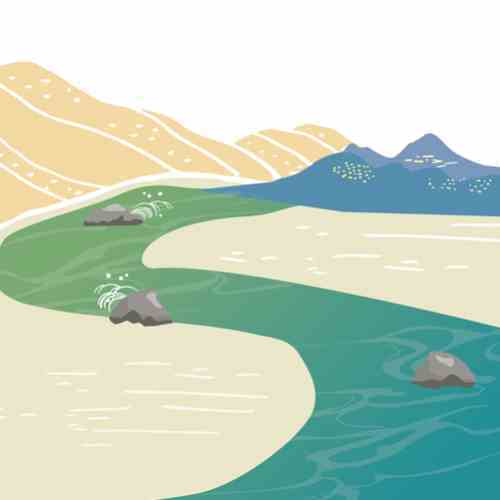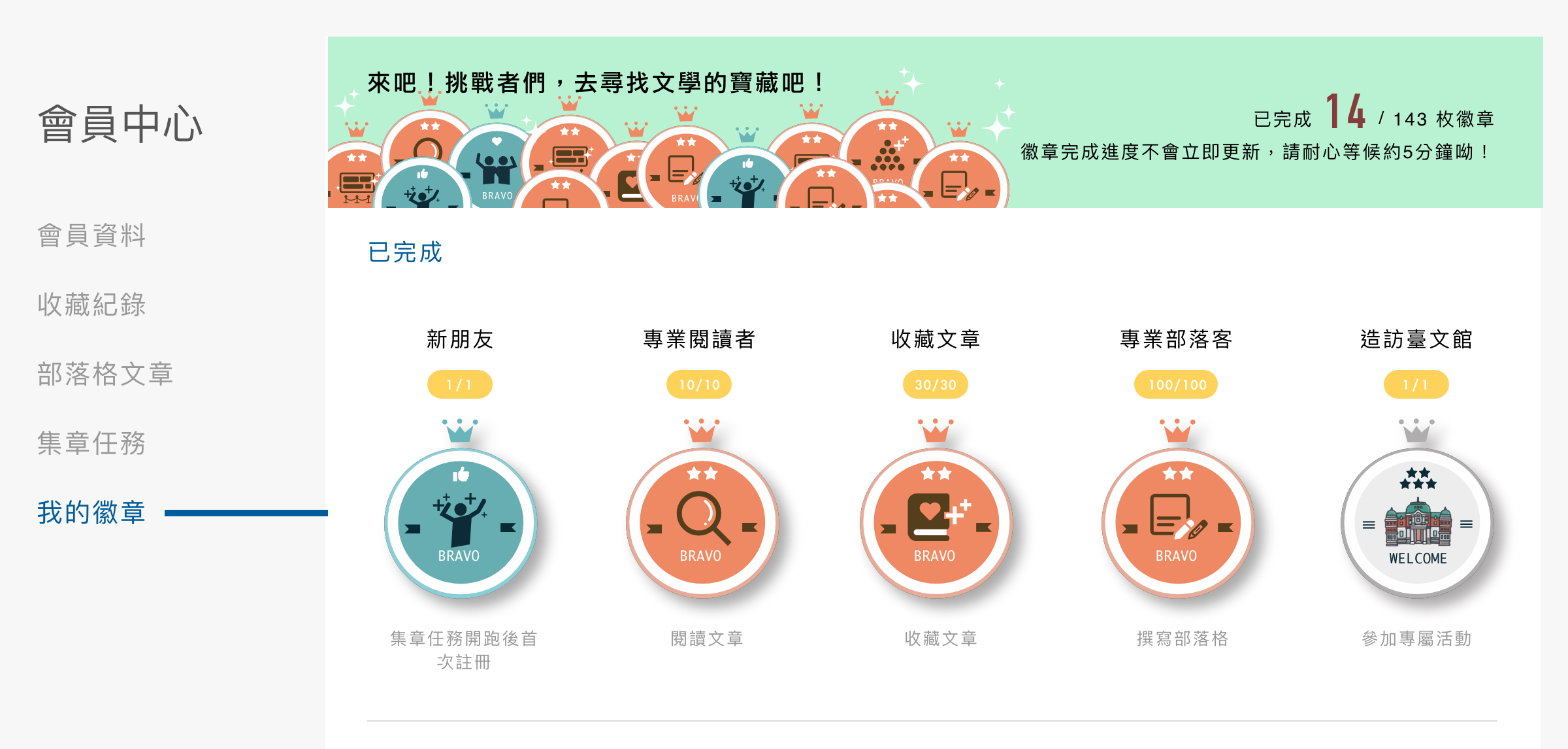Li Chiao|Tong Fang Po|Yao Chia-wen|Chen Yeh|Q&A
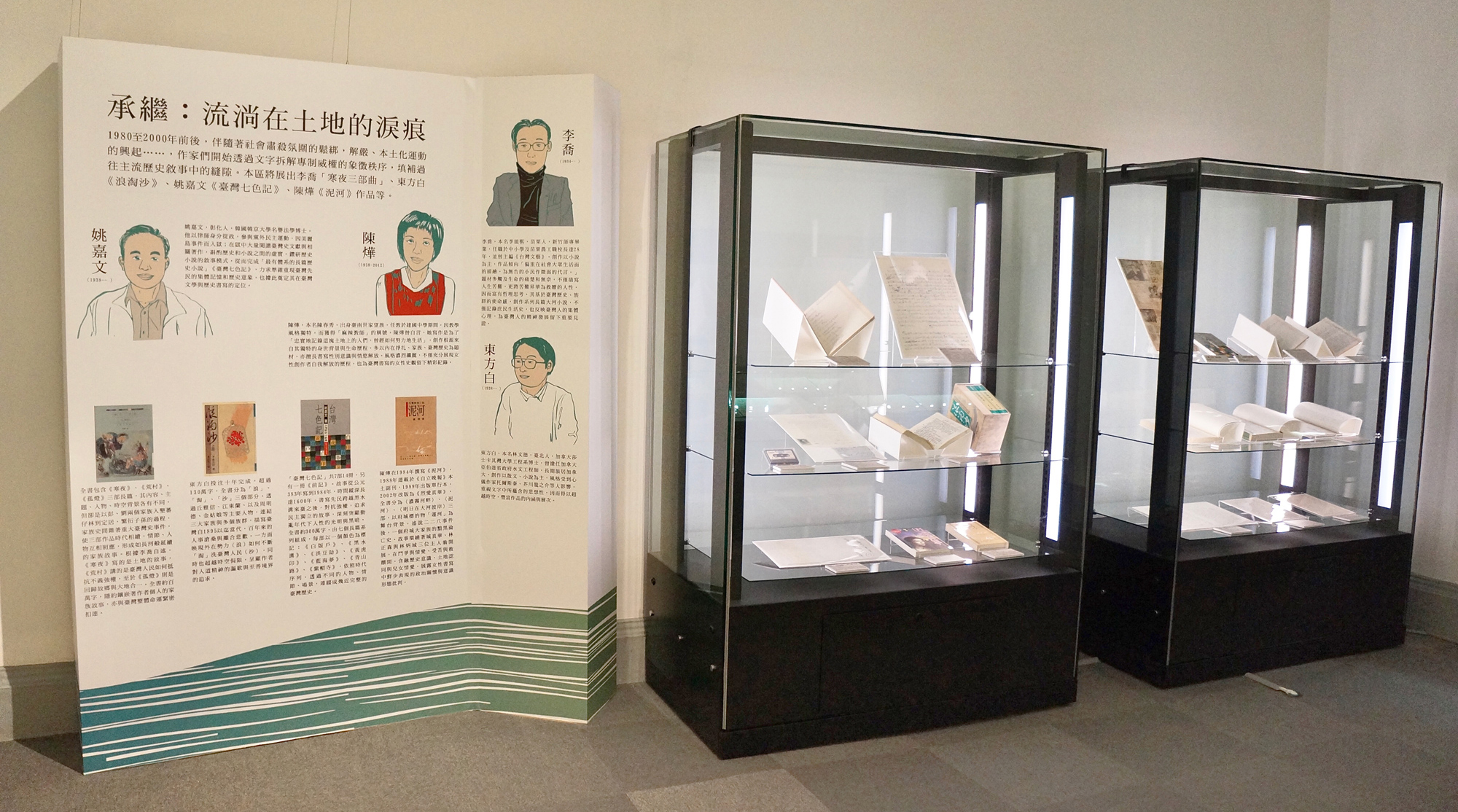
Between 1980 and 2000, the government loosened its control over society, martial law was lifted, and movements advocating nativism were initiated. Writers began to deconstruct the symbolic order of the authoritarian regime through words, attempting to fill in the gaps in the government-approved mainstream historical narrative. This section introduces Li Chiao's THE TRILOGY OF WINTRY NIGHT, Tong Fang Po's SAND IN THE WAVES, Yao Chia-wen's TAIWAN STORY OF SEVEN COLORS, and Chen Yeh's MUD RIVER, etc.
Li Chiao (1934- )

Born Lee Neng-chi. A native of Miaoli, Lee graduated from the Hsinchu Institute of Education, and taught for 28 years in elementary and high schools, as well as National Mao-Li Agricultural and Industrial Vocational High School. Lee was also the Editor-in-Chief for TAIWAN LITERATURE AND ART. His literary creation is mainly novels, which often depicts the livelihood of common people, and acts as the voice for the weak and neglected. His subject matter touches on the hardships and helplessness in life. While he describes the suffering, he also sublimates life's agonies in order to offer a sense of relief to humanity, making his works highly philosophical. Lee has a strong sense of purpose in speaking for Taiwanese history and ethnic groups through his Romans-Fleuves, not only acting as a documentary on how everyday people lived, but also reflecting on the collective mentality of Taiwanese, bequeathing an important testimony to the development of the Taiwanese spirit.
📚 THE TRILOGY OF WINTRY NIGHT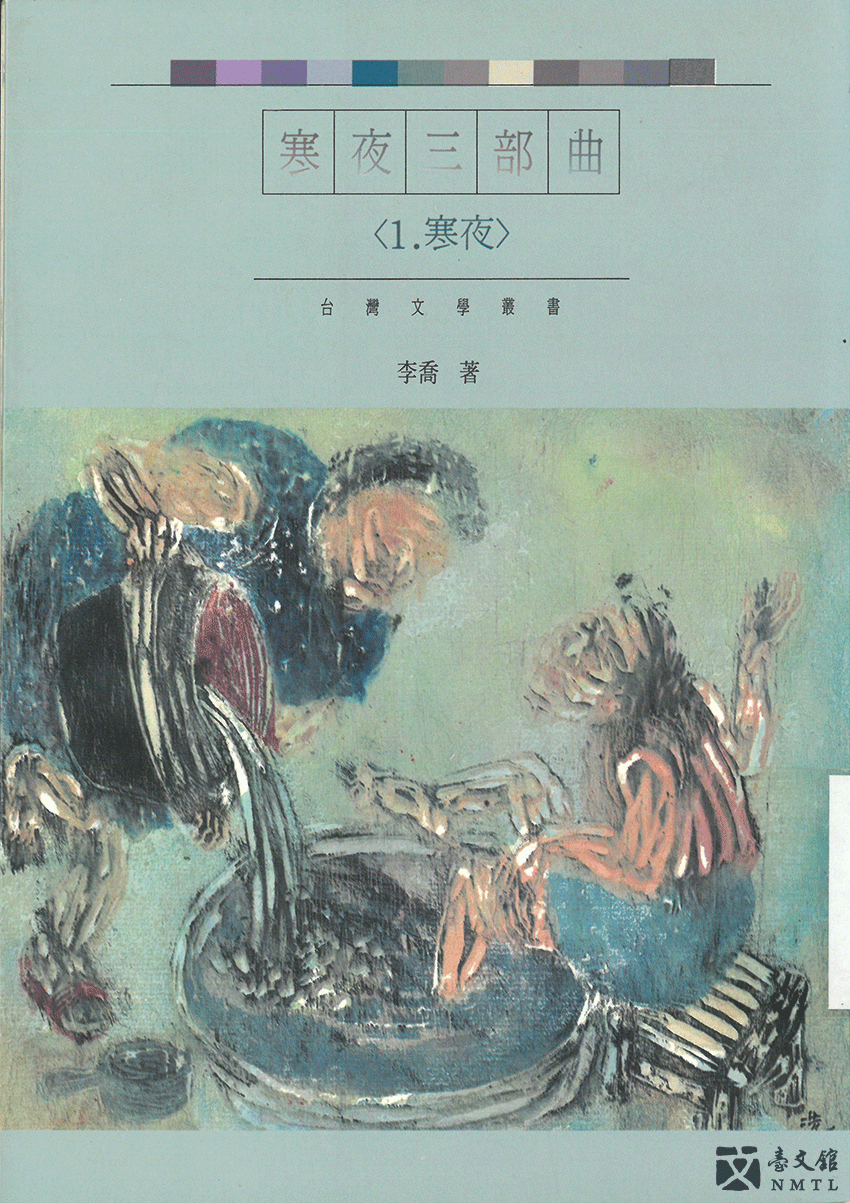
THE TRILOGY OF WINTRY NIGHT includes THE WINTRY NIGHT, THE DESOLATE VILLAGE and THE LONELY LANTERN. The content, themes, characters and timeframe of the 3 stories are entirely different, but all are centered on the development of two family clans, the Peng's and the Liu's, who came to settle in Fanzailin. In the process of the family's expansion, the family's history interweaved with major happenings in Taiwan's history, so that the plot and the characters correspond with each other, and the eras follow consecutively among the separate stories of the trilogy, as if they were all along the same river. According to Li Chiao's own recount, THE WINTRY NIGHT is a story about land; THE DESOLATE VILLAGE is a story about Taiwan people's fight against social prejudice and the authority; THE LONELY LANTERN is a story about returning to one's hometown and becoming one with the land. This is a one-million-word story, underlying the author's own family history, and closely knitted with the destiny of Taiwan.
People are made from soil, so they cannot be separated from it. They love the soil, and rely on the soil. Without soil, they cannot live. People are always working hard on the soil. In the future, people must also return to the soil.
──Li Chiao, THE WINTRY NIGHT, THE TRILOGY OF WINTRY NIGHT
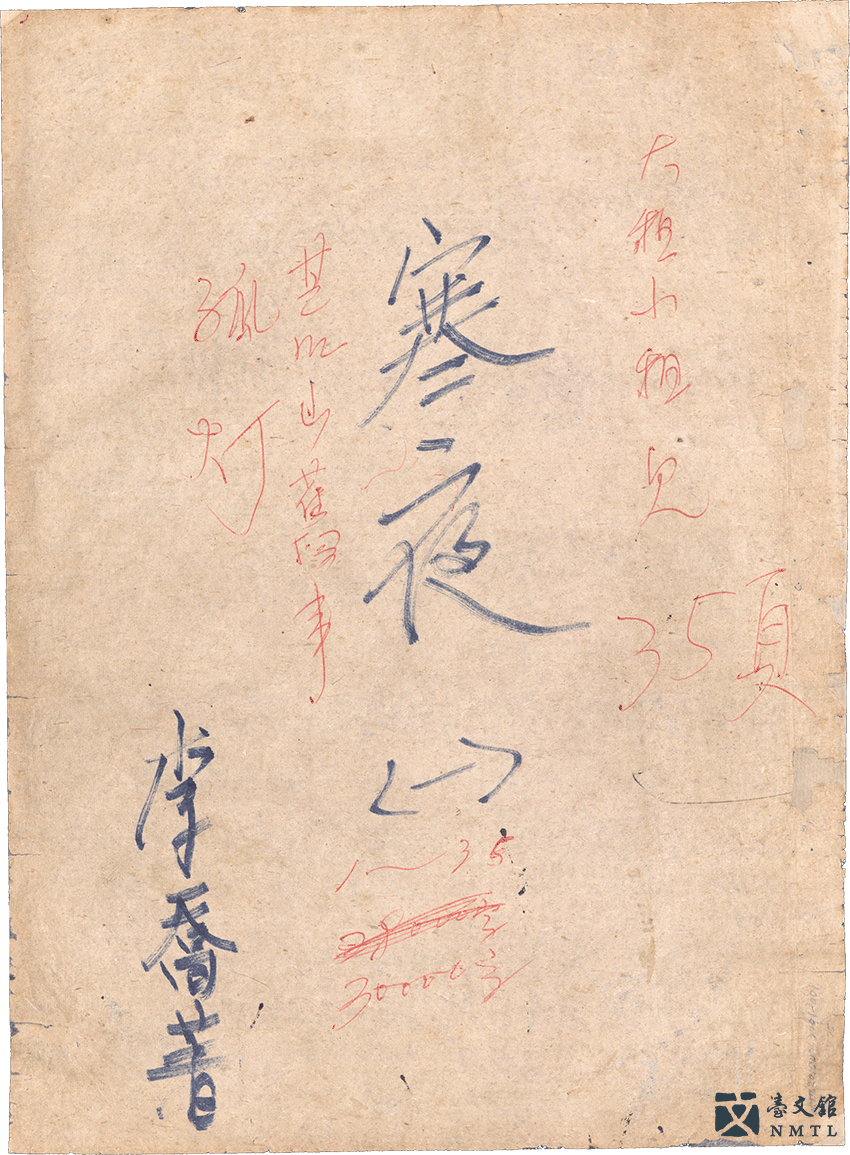
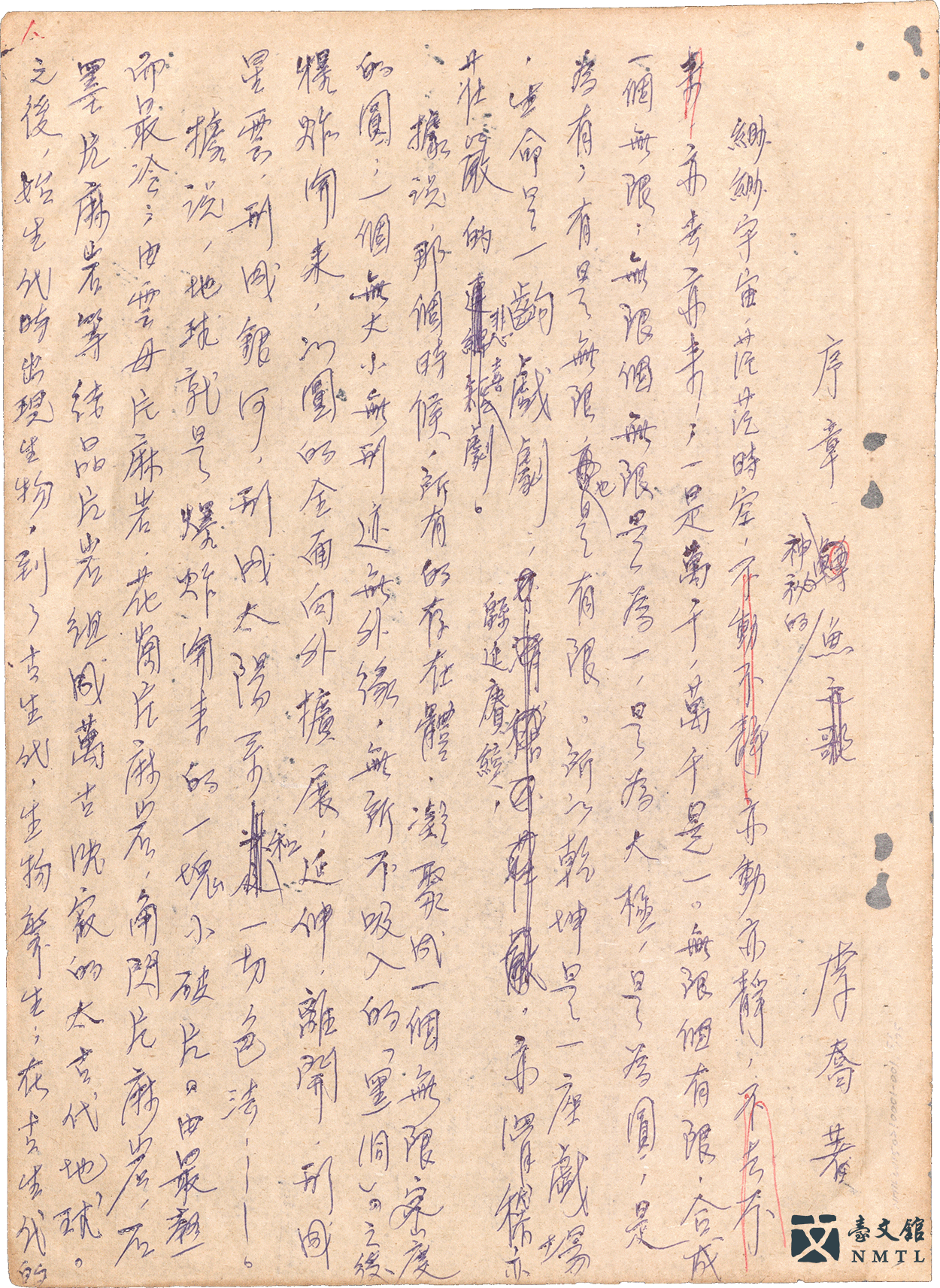
🌊 The manuscript of "Part 1 of THE TRILOGY OF WINTRY NIGHT: THE WINTRY NIGHT I" by Li Chiao|This museum houses 3 volumes of the manuscripts of THE WINTRY NIGHT, containing 226 pages in total. This work was Li Chiao's first long novel. It depicts the hardship of farmers when farming in the mountains in earlier times. It also depicts Taiwan's armed resistance against Japanese troops during the early days of colonial rule. The entire book highlights the great emotional attachment that Taiwanese feel toward their farmland. (Donated by Li Chiao / From the National Museum of Taiwan Literature permanent collection)
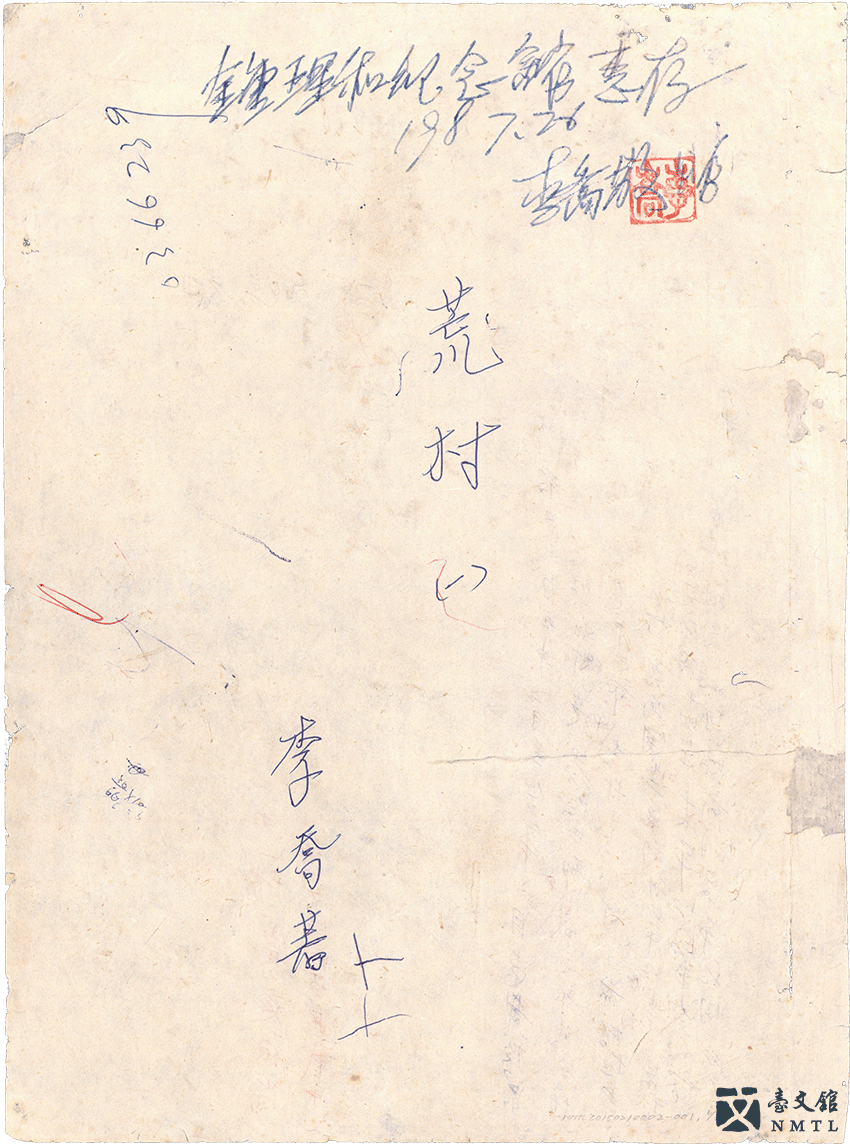
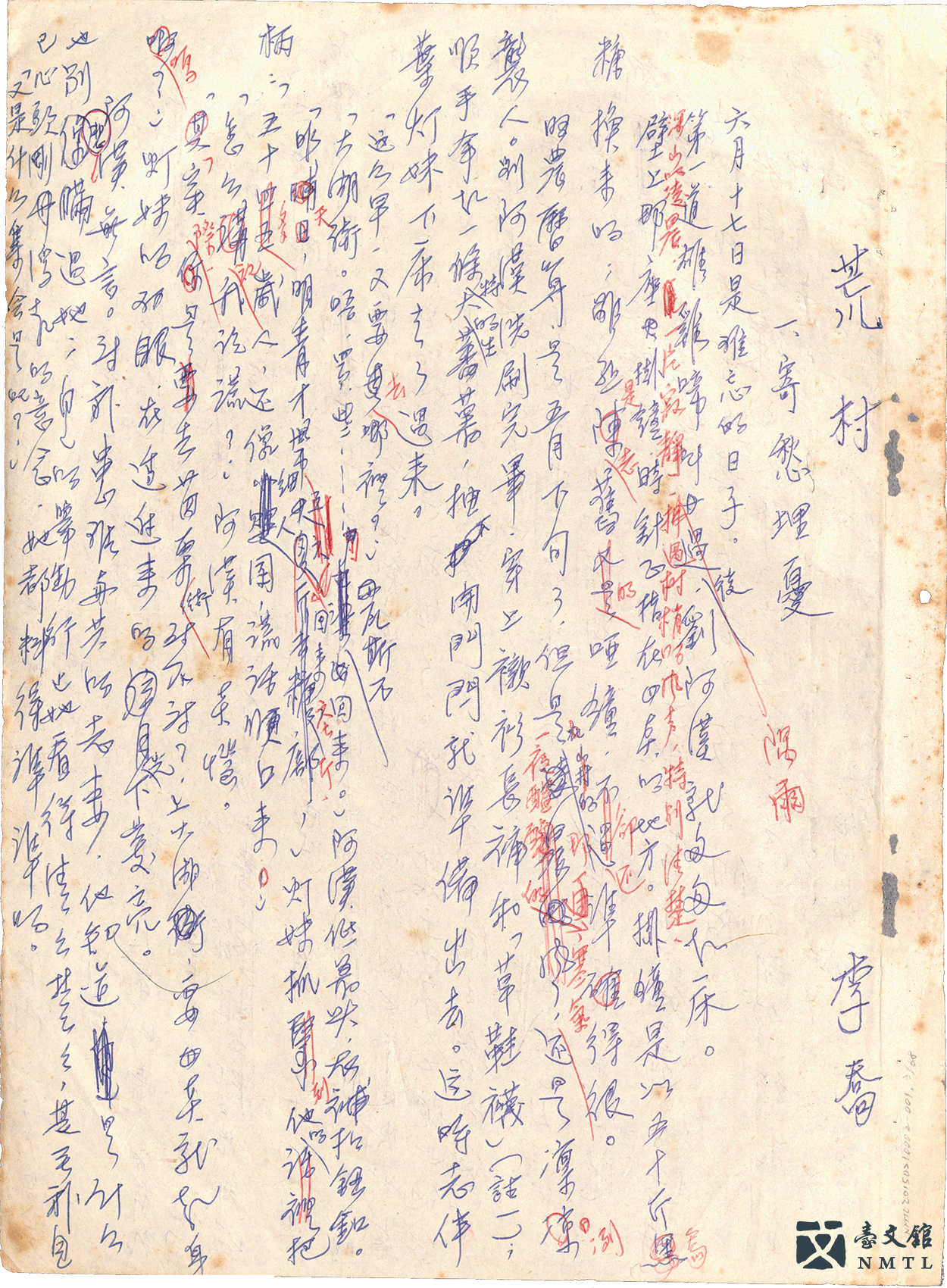
🌊 Li Chiao, THE DESOLATE VILLAGE, Volume 1, in THE TRILOGY OF WINTRY NIGHT 2, manuscript|The manuscript of THE DESOLATE VILLAGE consists of 551 pages in 8 volumes. Liu A-han, an anti-Japanese peasant, is the protagonist. The story is set against the middle period of Japanese rule, when there was a split in the Taiwan Cultural Association, and peasant farmers organized non-armed anti-Japanese movements. (Donated by Li Chiao / From the National Museum of Taiwan Literature permanent collection)
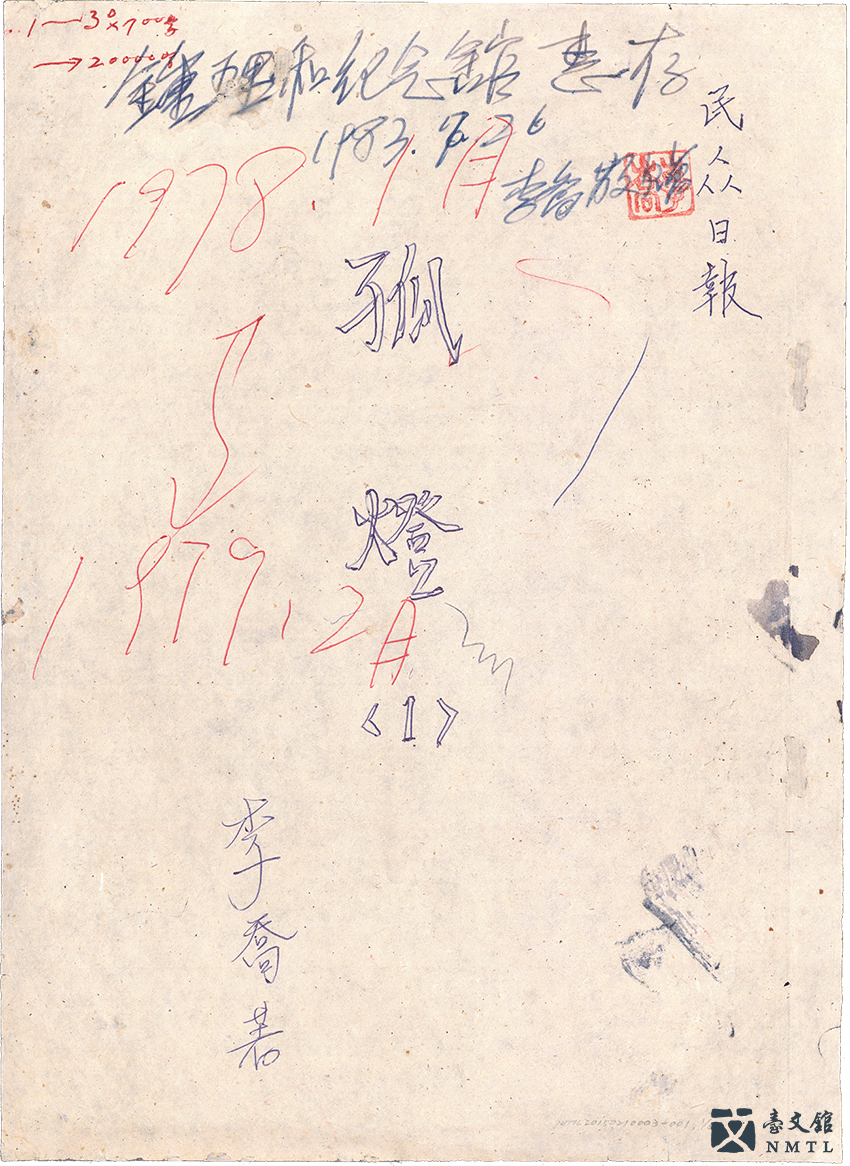
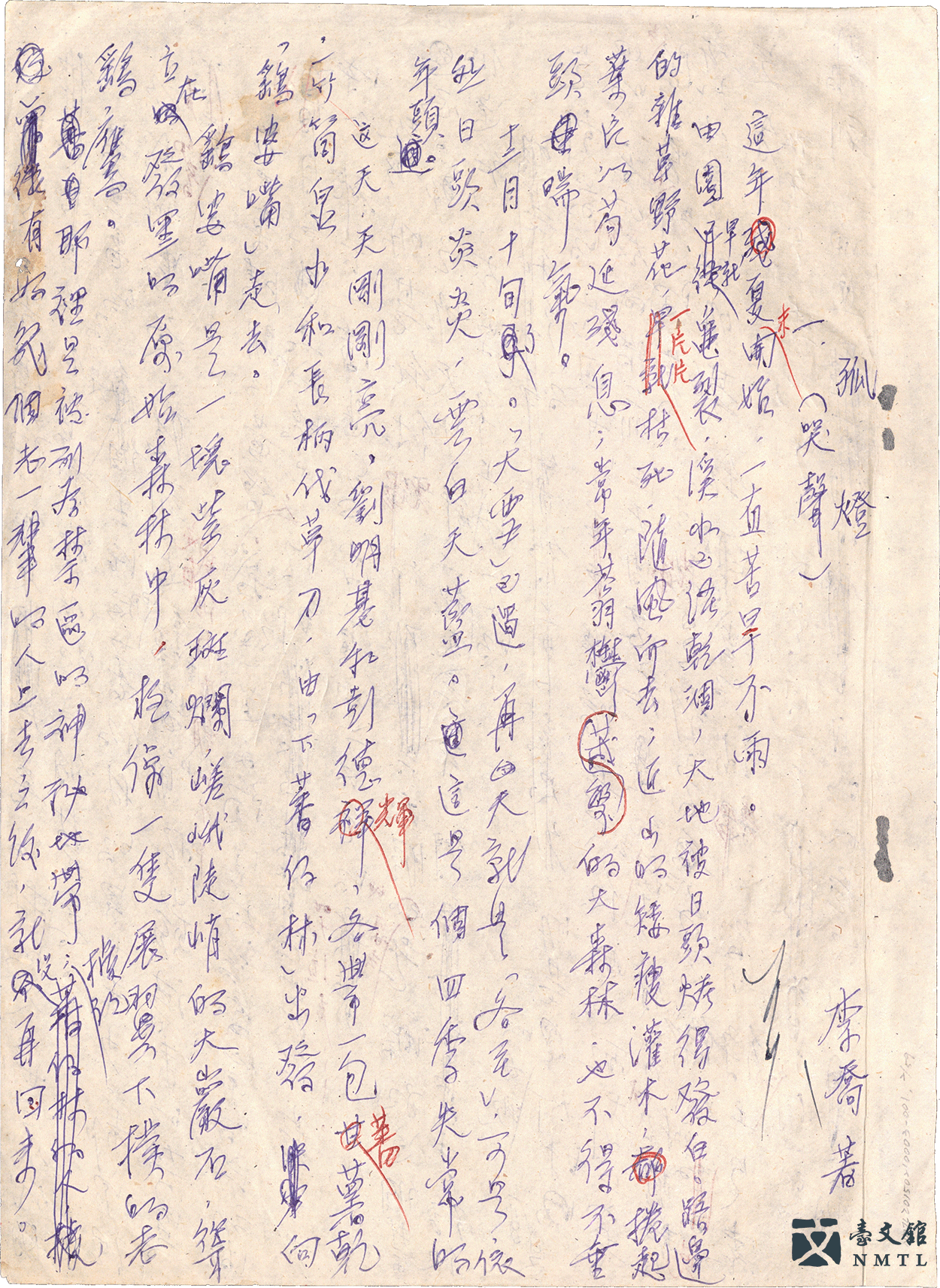
🌊 Li Chiao, THE LONELY LANTERN, Volume 1, in THE TRILOGY OF WINTRY NIGHT 3, manuscript|The manuscript of THE LONELY LANTERN consists of 570 pages in 10 volumes. The story is about the difficult livelihood of Taiwanese living among the mountain villages near the end of World War II. It was also the time when Taiwanese youth had to participate in the wars in the South Sea, a time of blood and sorrow for Taiwan people. (Donated by Li Chiao / From the National Museum of Taiwan Literature permanent collection)
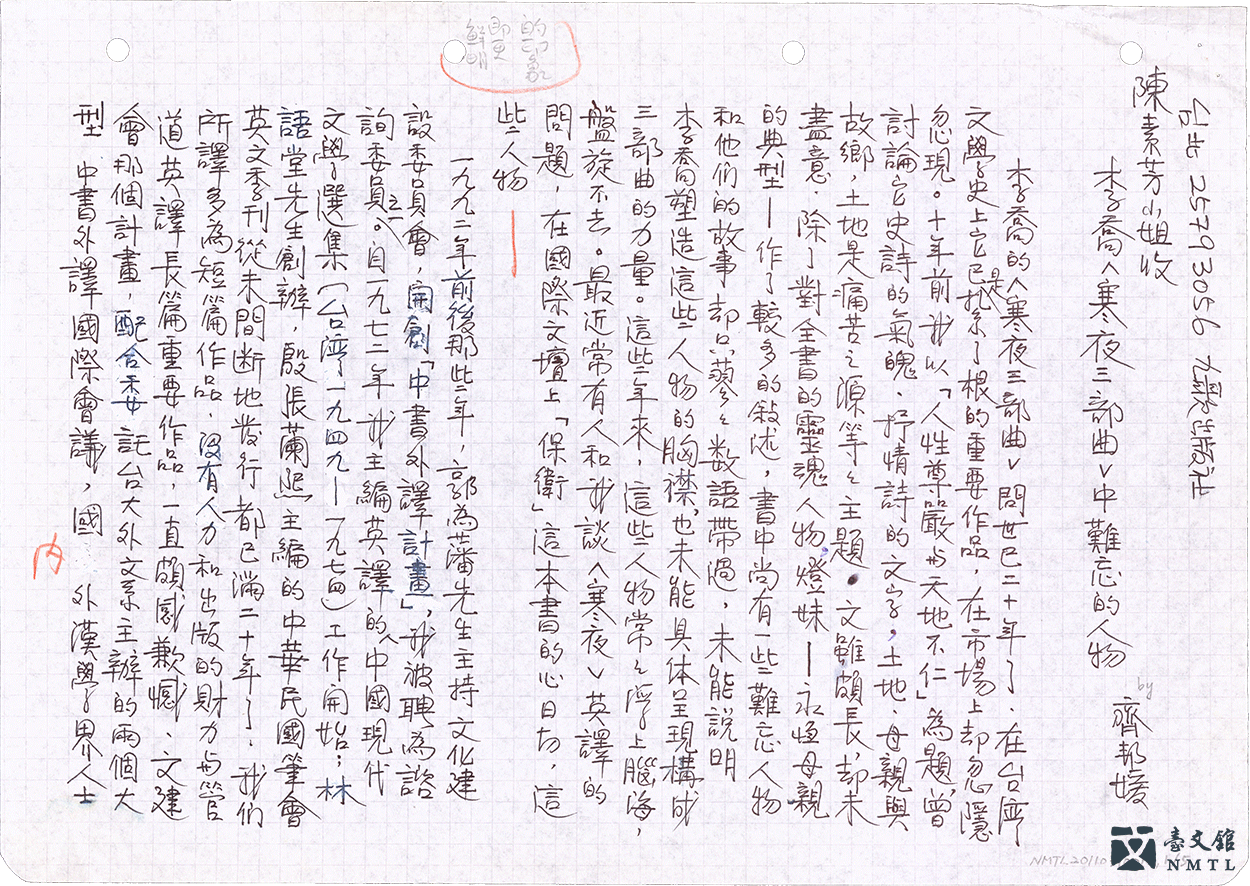
🌊 Chi Pang-yuan, The Unforgettable Character in THE TRILOGY OF WINTRY NIGHT by Li Chiao, manuscript|This article was written by Professor Chi Pang-yuan during her trip to the Rhine in Germany. She detailed the process of the English translation plans for THE TRILOGY OF WINTRY NIGHT, and expressed her strong sentiments for defending this work in the international literary world, "What we insist on defending is the importance this book has to the history of Taiwan, and also its offering of consolation to the marginalized people amidst the ruthless exploration by mankind." By the coordination of Professor Chi, Professor Wang Te-wei and Professor Liu Tao-tao, THE TRILOGY OF WINTRY NIGHT was abridged to 300 thousand words, titled WINTRY NIGHT, and was published by the Columbia University Press in New York in 2001. (Donated by Chi Pang-yuan / From the National Museum of Taiwan Literature permanent collection)
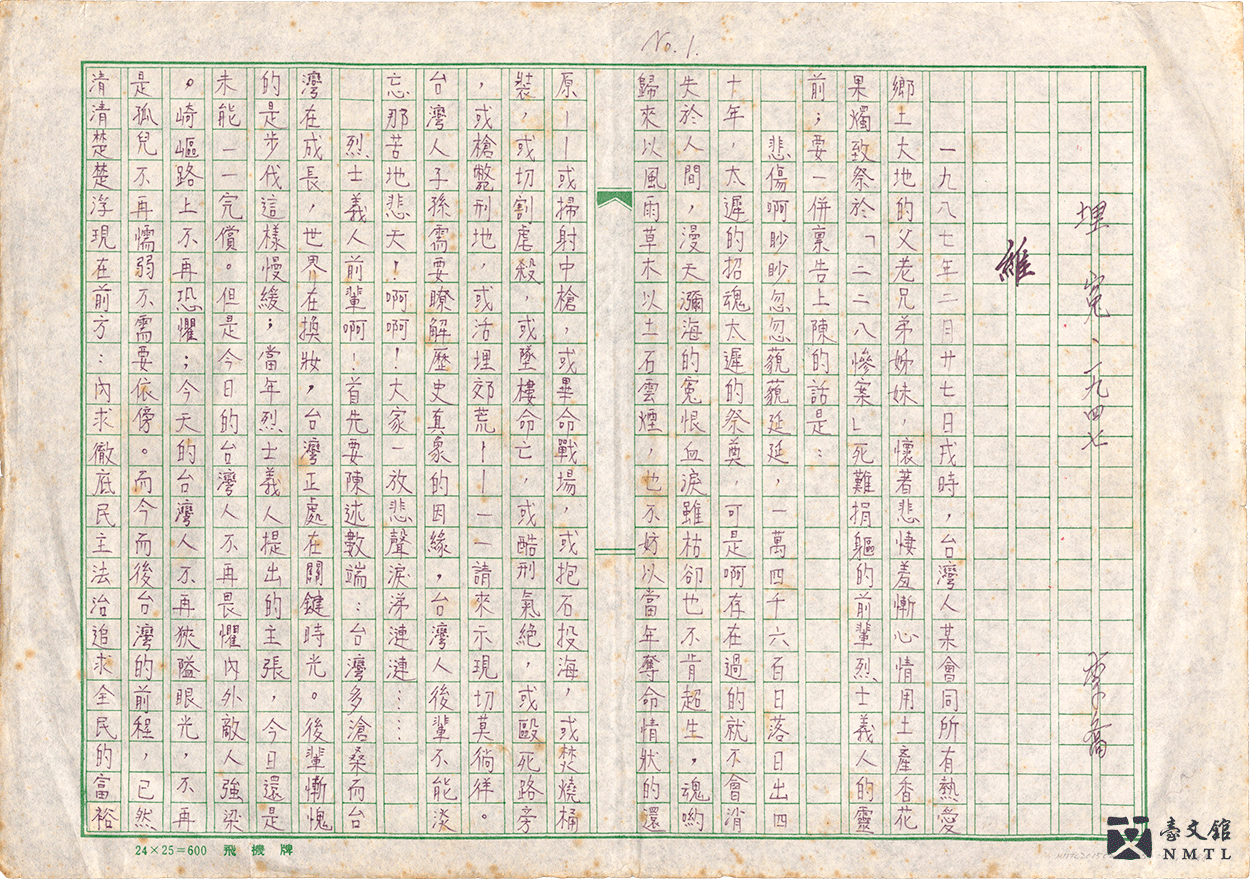
🌊 Li Chiao, GRIEVANCES BURIED, 1947, manuscript|The manuscript of Volume 1, GRIEVANCES BURIED 1947 GRIEVANCES BURIED consists of 588 pages. It is an account of the 228 Incident, wherein Lin Jiang-mai, a cigarette seller, was hit accidentally by investigators from the Tobacco Monopoly Bureau on February 27, 1947, causing a large-scale rebellion against the government by the general public. The author wrote meticulously about the Taiwanese youth and elites being imprisoned, killed, or even tragically massacred. The author commemorated the victims in the incident through the characters in the novel, such as "Chang Qi-lang" in Fenglin, Hualien, who is an allusion to the actual victim Zhang Chi-lang the Physician. (Donated by Li Chiao / From the National Museum of Taiwan Literature permanent collection)
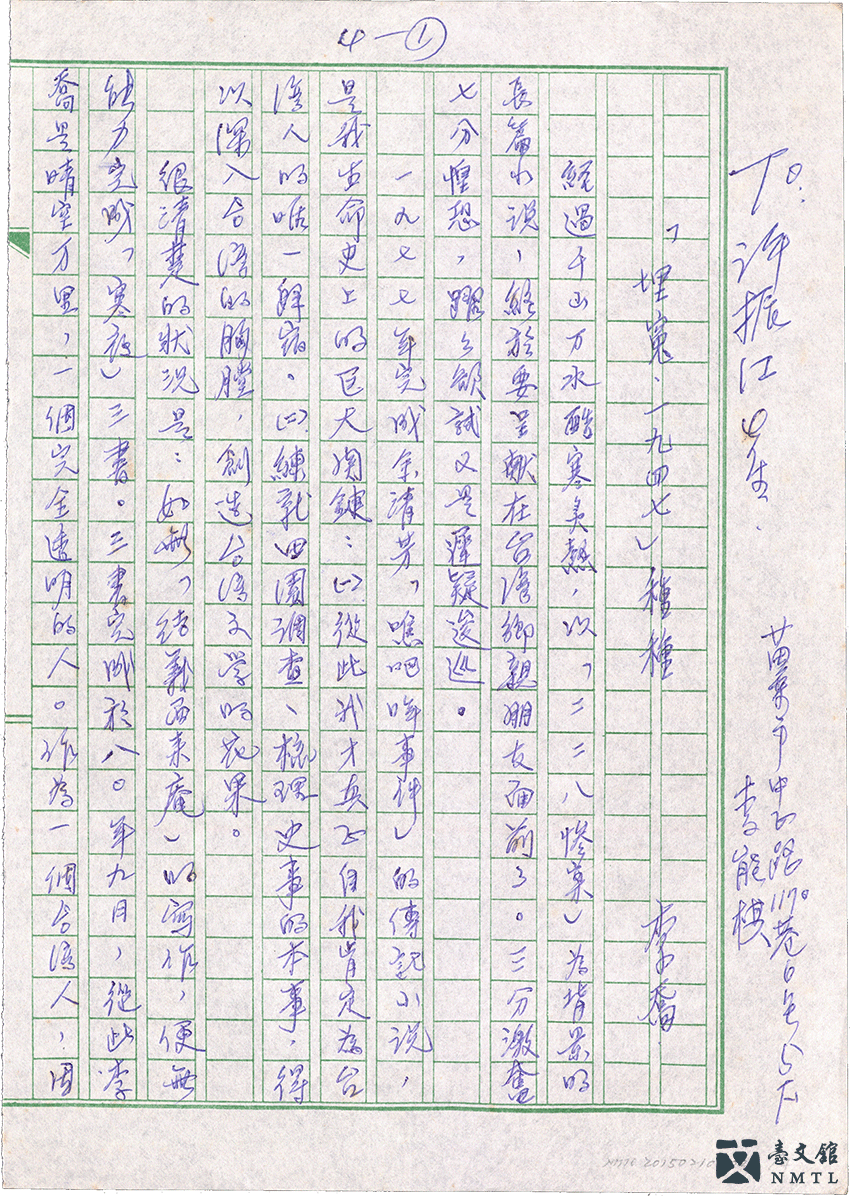
🌊 Li Chiao, everything about GRIEVANCES BURIED 1947, manuscript|This article is Li Chiao's own account of his psychological journey during the writing of GRIEVANCES BURIED 1947 GRIEVANCES BURIED. He mentioned that GRIEVANCES BURIED had plunged him into a struggle between historical reality and fictional creation, so that he had pondered for a year before putting it into writing. He considered the acts "to present the full picture of the 228 Incident and to liberate its implications" his calling in life, almost like a debt to the land of Taiwan, so that through the conclusion to this piece of work, Li felt his "debt has been cleared." (Donated by Li Chiao / From the National Museum of Taiwan Literature permanent collection)
Tong Fang Po(1938- )

Born Lin Wen-te. A native of Taipei, Dongfang graduated with a PhD in Engineering from the University of Saskatchewan. He served as hydrological engineer in Alberta, a Canadian province, for an extensive period of time. His literary works are mainly prose and novels. His style is influenced by his favorite authors including Tolstoy and Ryūnosuke Akutagawa. As such he greatly values the ideological implications behind words, traversing time and space to achieve works with immense depth and substance.
📚 SAND IN THE WAVES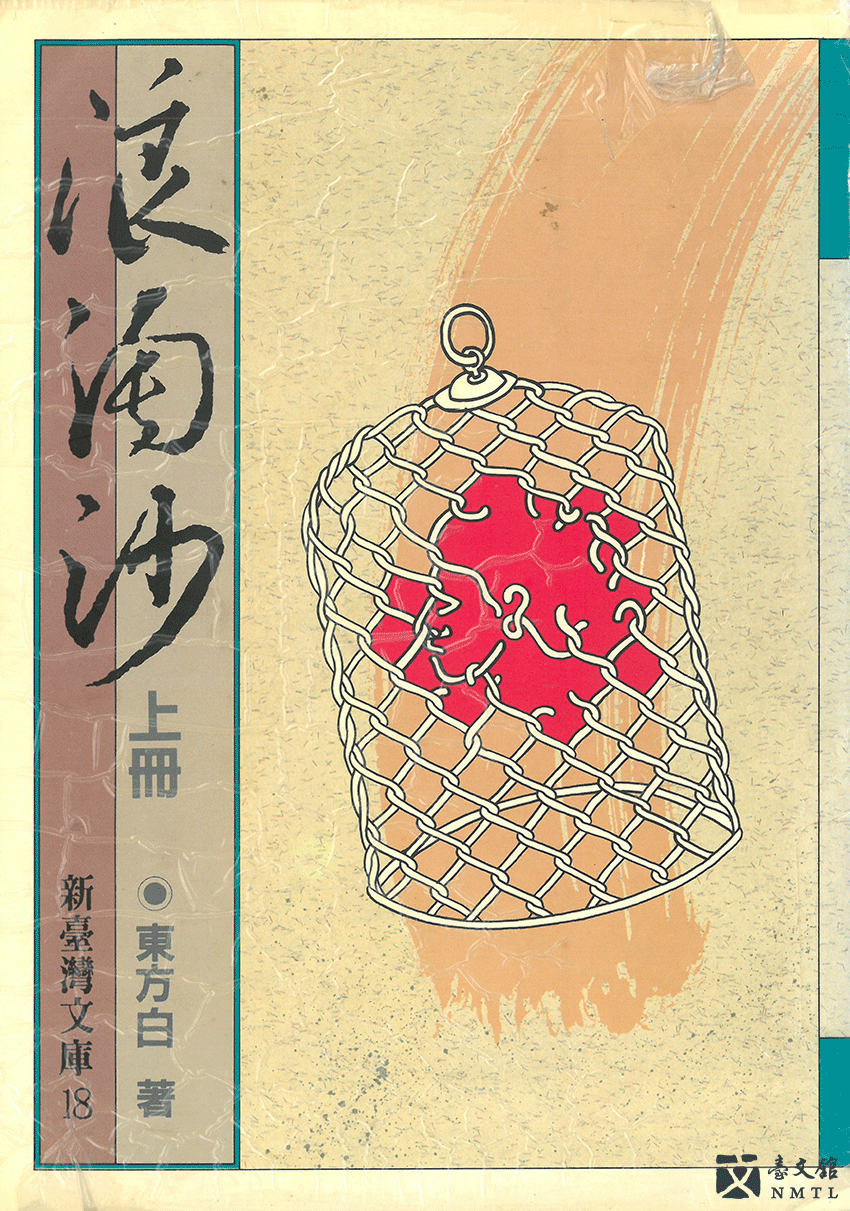
Tong Fang Po invested ten years and 1.3 million words into SAND IN THE WAVES. The story is divided into 3 parts: "Lang", "Tao" and "Sha." Through the main characters: Qiu Ya-xin, Jiang Dong-lan, Zhou Ming-de and Miss Jin, 3 family clans and numerous ethnic groups were threaded throughout the history of Taiwan from 1895 to modern times, narrating the vicissitudes of life, and the epic ups and downs over a century. "Lang" (meaning "waves") symbolizes the external forces that kept on "washing away" ("Tao") the "sand" ("Sha," meaning "the Taiwan people"). At the same time, the story rises above the limitations of space and time to show the author's tribute to humanitarianism and the pursuit of perfection.
The boundless Tamsui River is shimmering and shivering under the sun, and the surface of the river is gradually tapering off, finally disappearing among the ships lined with tall sails. On the right bank of the river, thrusting above the shoal, is the verdant Guanyinshan…
──Tong Fang PO, SAND IN THE WAVES
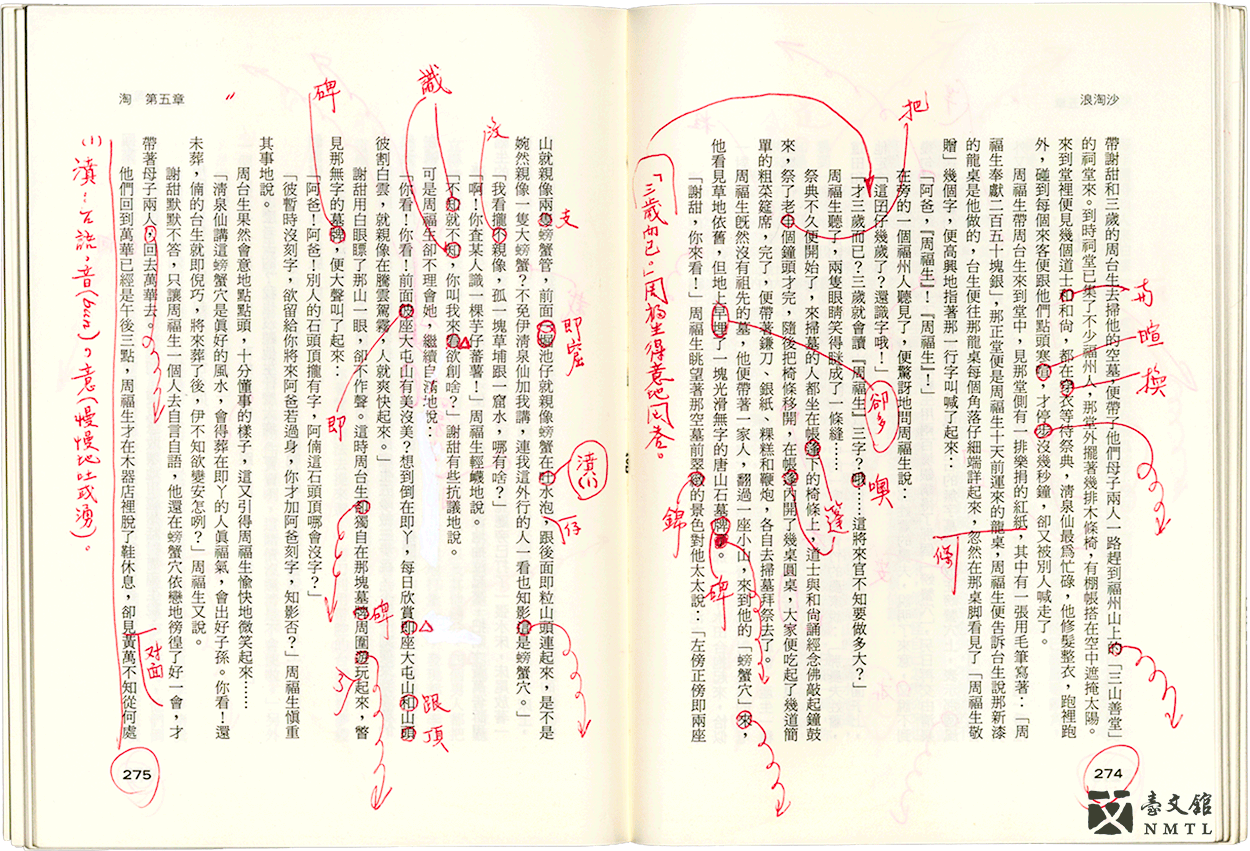
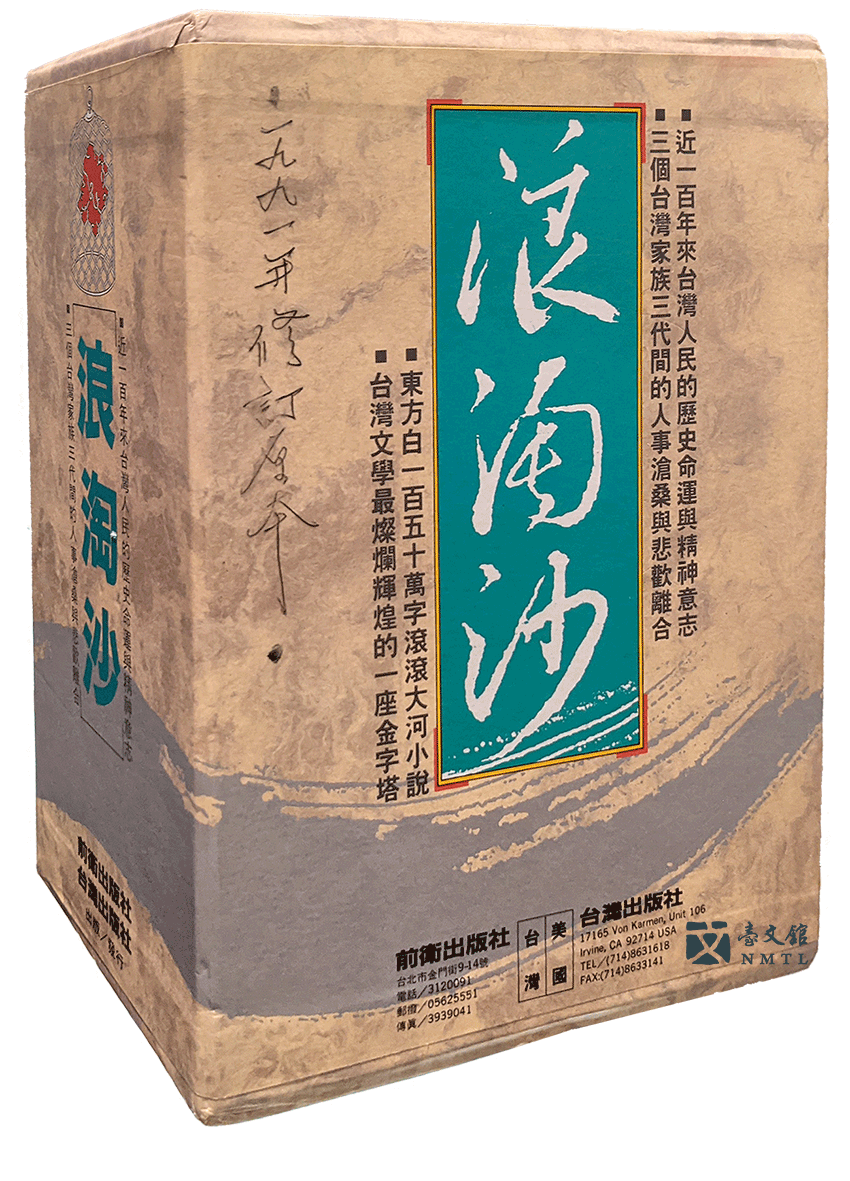
🌊 Tong Fang Po, SAND IN THE WAVES|Taipei: Avanguard Publishing House, 1991.
The first edition of SAND IN THE WAVES was published in 1990, with revised editions further released in 1991, 1994, 1996 and 2005. In the 1991 edition, Tong Fang Po added a "Preface to Revised Edition," an update to the "Bibliography of Tong Fang Po's work" and "Chronology of Tong Fang Po's works" after the main text, and the publication message for the edition in 1991. These all exemplified how the author cared about and valued this piece of work. (Donated by Tong Fang Po / From the National Museum of Taiwan Literature permanent collection)
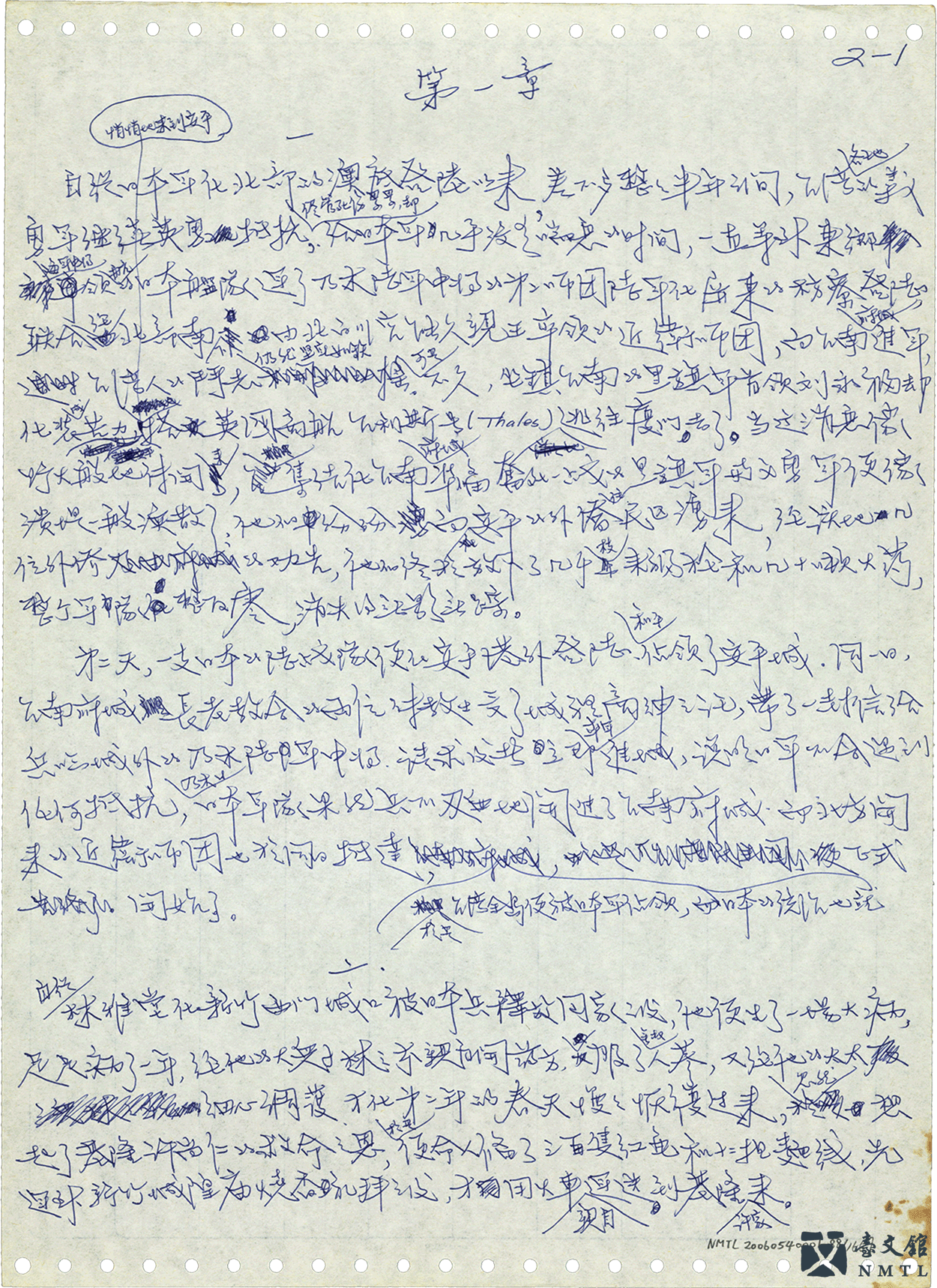
🌊 The manuscript of Tong Fang Po's SAND IN THE WAVES|Tong Fang Po began writing SAND IN THE WAVES in 1979. It was completed in 1989. The book contains 1,667 pages and over 1.3 million words. When writing this book, he even suffered from depression and had to stop for a while. The story starts from 1895 as Japanese troops arrive in Taiwan and spans more than a century of time. It is set in East Asia and Southeast Asia. The protagonists, Qiu Ya-xin, Jiang Dong-lan, and Zhou Ming-de, represent three people who actually existed: Tsai Ah-Xin (first female doctor in Taiwan), Zhang Dong-lan (former principal of Hsinchu High School), and Chen Min-de (former teacher of Chenggong High School). The author met them in Canada and wrote their family stories into a roman-fleuve after obtaining their consent. (Donated by Tong Fang Po / From the National Museum of Taiwan Literature permanent collection)
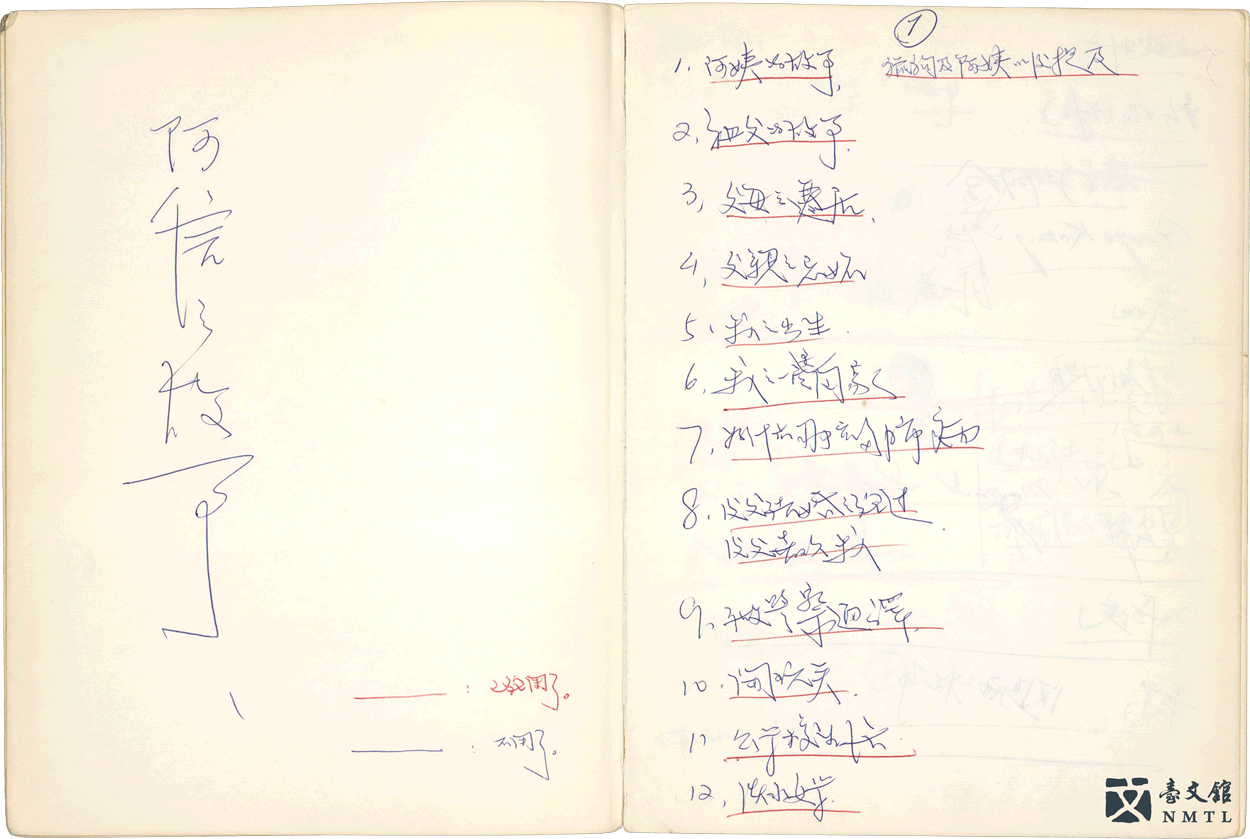
🌊Tong Fang Po, the Creative Notes of SAND IN THE WAVES, Volume 1, manuscript|This is the creative notes of SAND IN THE WAVES. Tong Fang Po did a lot of preparation work before the proper writing, such as conducting interviews, collecting information, conducting field research and organizing folk customs and proverbial sayings. In addition, he had read a lot of classical literary works, such as Tolstoy, Ryunosuke Akutagawa and Cao Xue-qin's "Dream of the Red Chamber", regarding all of which he made notes and analyses. These showed the author having a grand project mentality towards the creation of Romans-Fleuves, making sure he was well prepared before and during the writing process. (Donated by Tong Fang Po / From the National Museum of Taiwan Literature permanent collection)
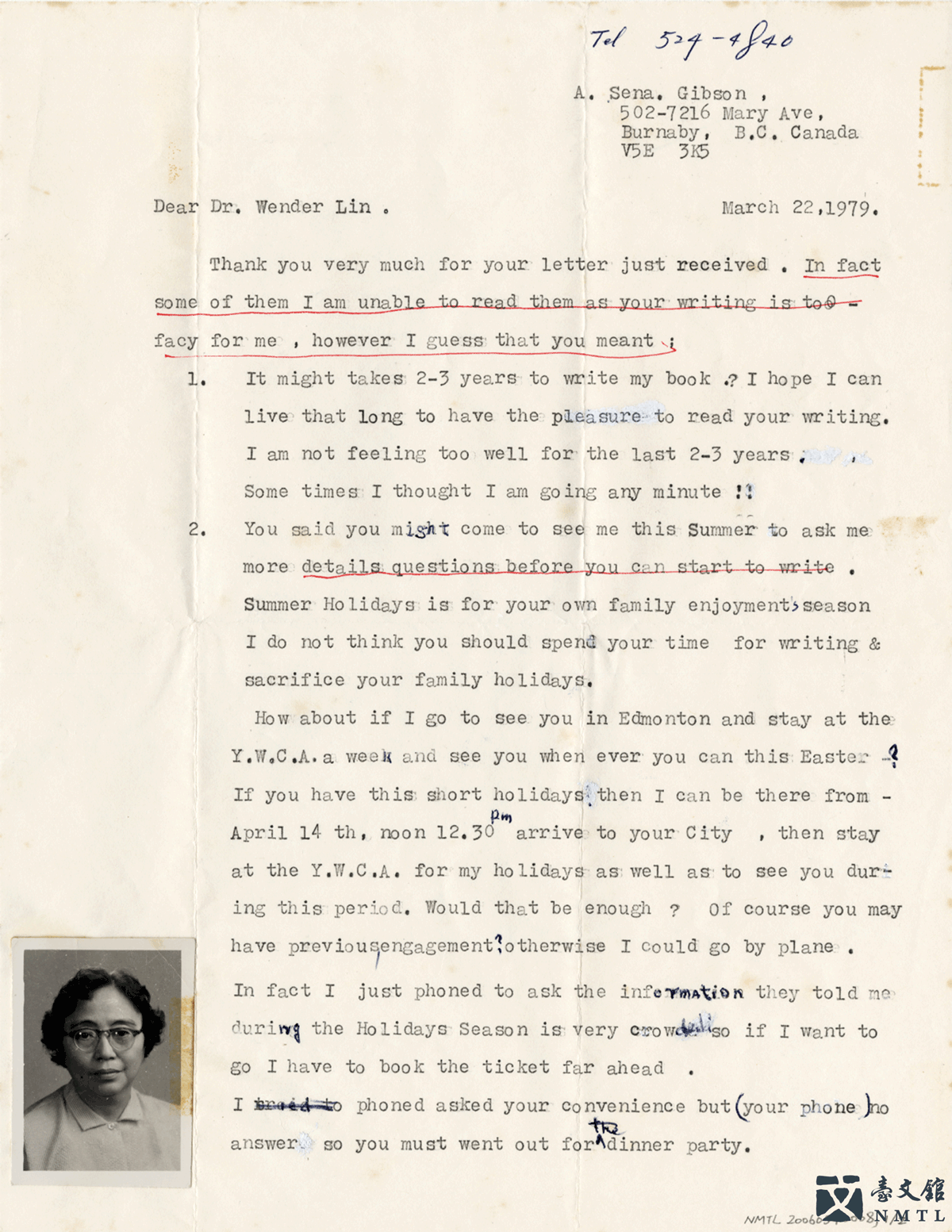
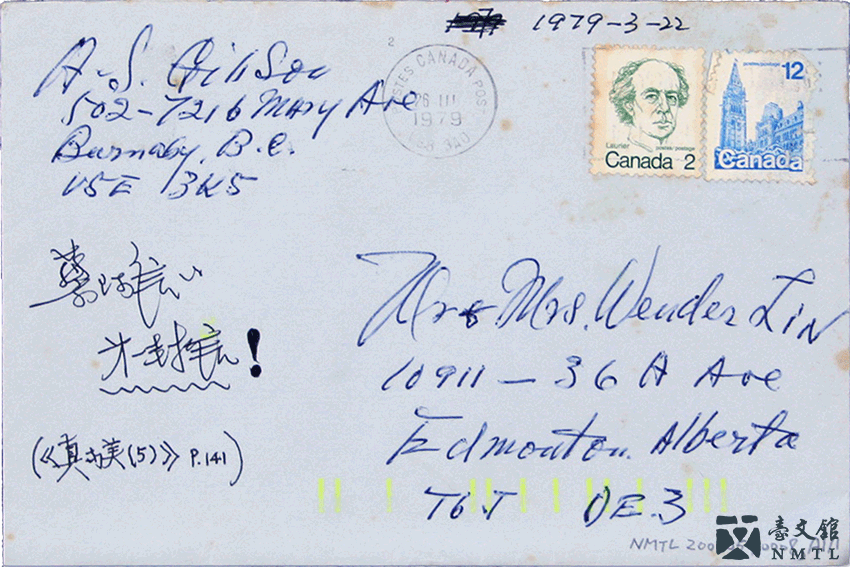
🌊 Tsai Ah-hsin's letter to Tong Fang Po|Mar. 22, 1979. To write about Tsai Ah-hsin, Dongfong Bai exchanged letters and conducted interviews with Tsai. According to Tong Fang Po's footnotes on the envelope, this was Tsai's first letter to him. From the letter content, it seemed that they had not met each other before. And possibly for that reason, Tsai included a photo of herself on the lower left corner of the letter. It appeared Tong Fang Po was to visit Tsai that following Summer so as to know more about Tsai's life. Tsai replied thoughtfully, telling Tong Fang Po that he should not sacrifice the vacation time with his own family for the writing work, and instead suggested that she visit Tong Fang Po in April during the Easter holidays. (Donated byTong Fang Po / From the National Museum of Taiwan Literature permanent collection)

🌊 Cassette tape recordings of Tong Fang Po's interview with Tsai Ah-hsin|From August 4thto August 6th in 1979, Tong Fang Po finally was able to conduct face-to-face interview with Tsai Ah-hsin. During those 3 days, 6 cassette tapes were produced, recording bits and pieces of Tsai's life, which served as important materials for the novelist in his writing. (Donated by Tong Fang Po / From the National Museum of Taiwan Literature permanent collection)
Yao Chia-wen (1938- )

A native of Changhua. Yao attained an Honorary Doctor of Laws at Hankyong National University, South Korea. He began his political life as a lawyer, and participated in the Tangwai movement. He was imprisoned due to the Formosa Incident. While in prison, he read a lot of Taiwanese history and related literary works, and contemplated the facts and fiction of the history and the novels, and accomplished TAIWAN STORY OF SEVEN COLORS, considered "the most systematic historical long novel." He strived to recreate the collective memories and historical vision of Taiwanese ancestors, and in so doing established himself in Taiwanese literary and historical writing.
📚 TAIWAN STORY OF SEVEN COLORS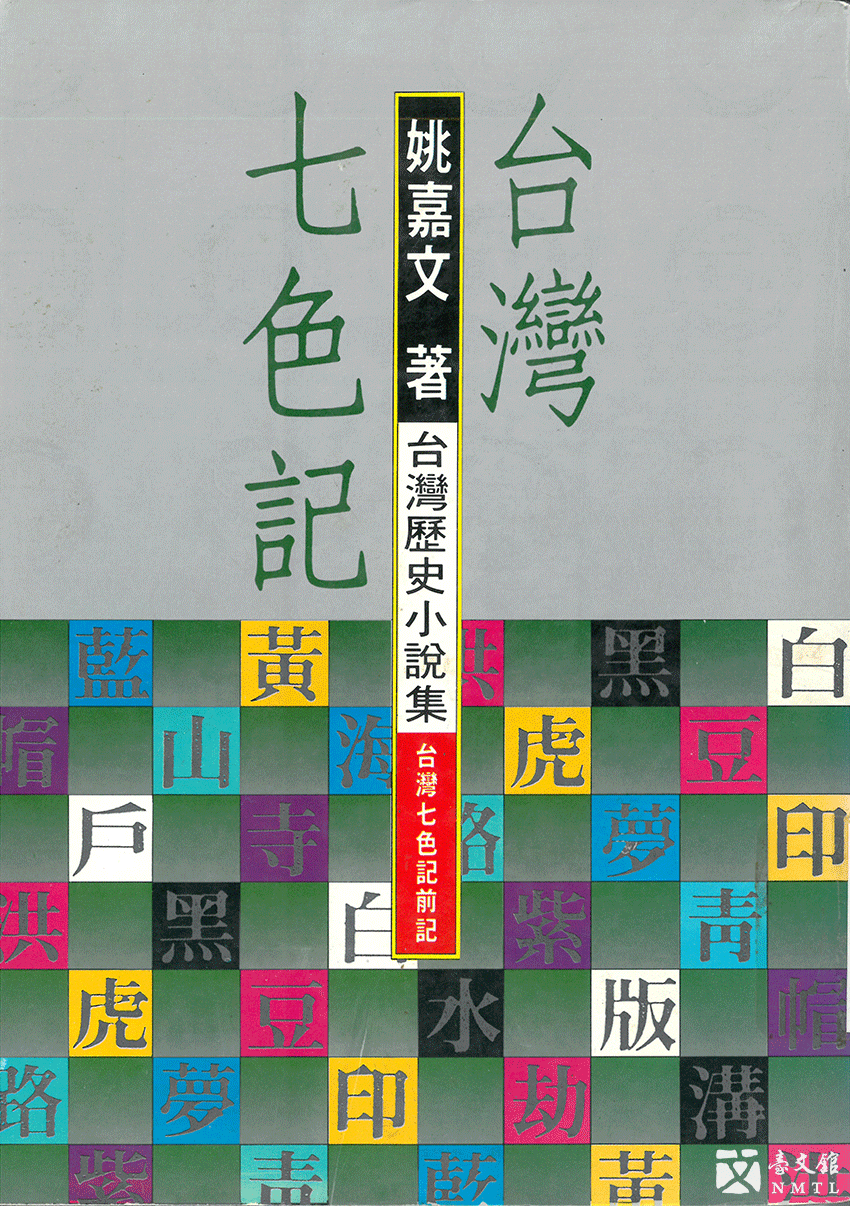
TAIWAN STORY OF SEVEN COLORS has 7 tales and 14 volumes, as well as a separate "PREFACE" volume. The story happened during AD383 to 1984, spanning 1,600 years in total. The story began with early ancestors crossing the "black ditch" (i.e., Taiwan Strait), thereafter fighting against hegemony in search of democratic independence. The dark and bright sides of humanity in the face of social turmoil were therein put under spotlight. In about 3 million words, the story consists of 7 long tale series; each tale is assigned one color: "PAI PAN HU" (white), "HEI SHUI KOU" (black), "HONG TOU CHIEH" (red), "HUANG HU YIN" (yellow), "LAN HAI MENG" (blue), "CHING SHAN LU" (green) and "TZU MAO SU" (purple), all listed chronologically. Through the different characters, plots and scenes, the history of Taiwan is almost presented in its complete picture.
A person who has lost or distorted his memory cannot have a complete experience, so he cannot have a complete life. This is true for a person, as much as it is for a nation.
──Yao Chia-wen, Preface to TAIWAN STORY OF SEVEN COLORS
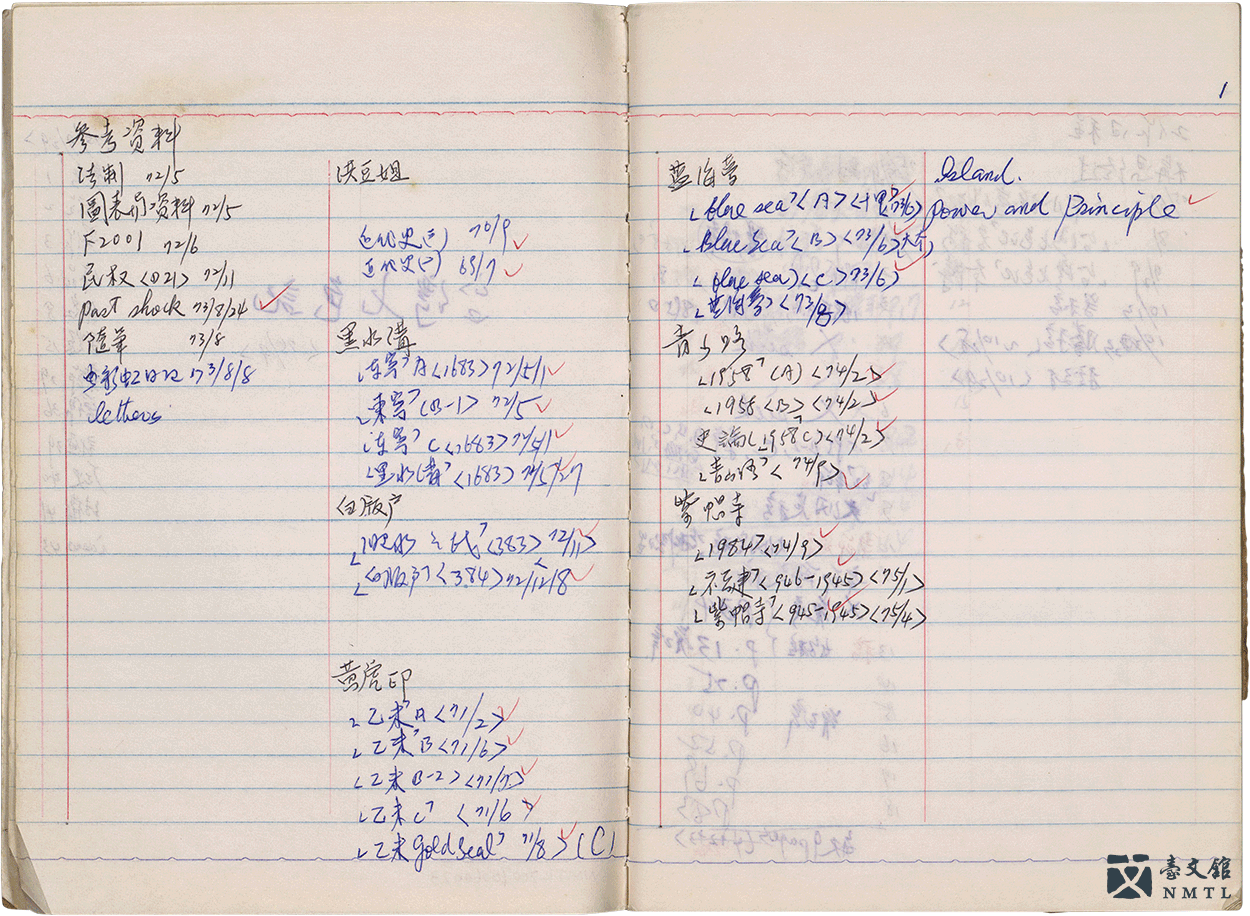
🌊 Yao Chia-wen, Taiwan Story of Seven Colors, manuscript|This is Yao Chia-wen's organized notes for the novel series TAIWAN STORY OF SEVEN COLORS. According to the content of the notebook, there are 12 items: "reference, schedule, writing, works, naming, themes, chapters, writing, planning, history, structure, and ideas." The references, working schedule, creative process, and also the writing work arrangements while the author was in jail from Dec. 13, 1979 to Jan. 1987 are all recorded in detail. In the novel series TAIWAN STORY OF SEVEN COLORS, the information on the conception dates, working months, chapter number, and total number of words are presented in a table format, which serve as a comprehensive record of the author's creative process, from the beginning to the completion. (Donated by Yao Chia-wen / From the National Museum of Taiwan Literature permanent collection)
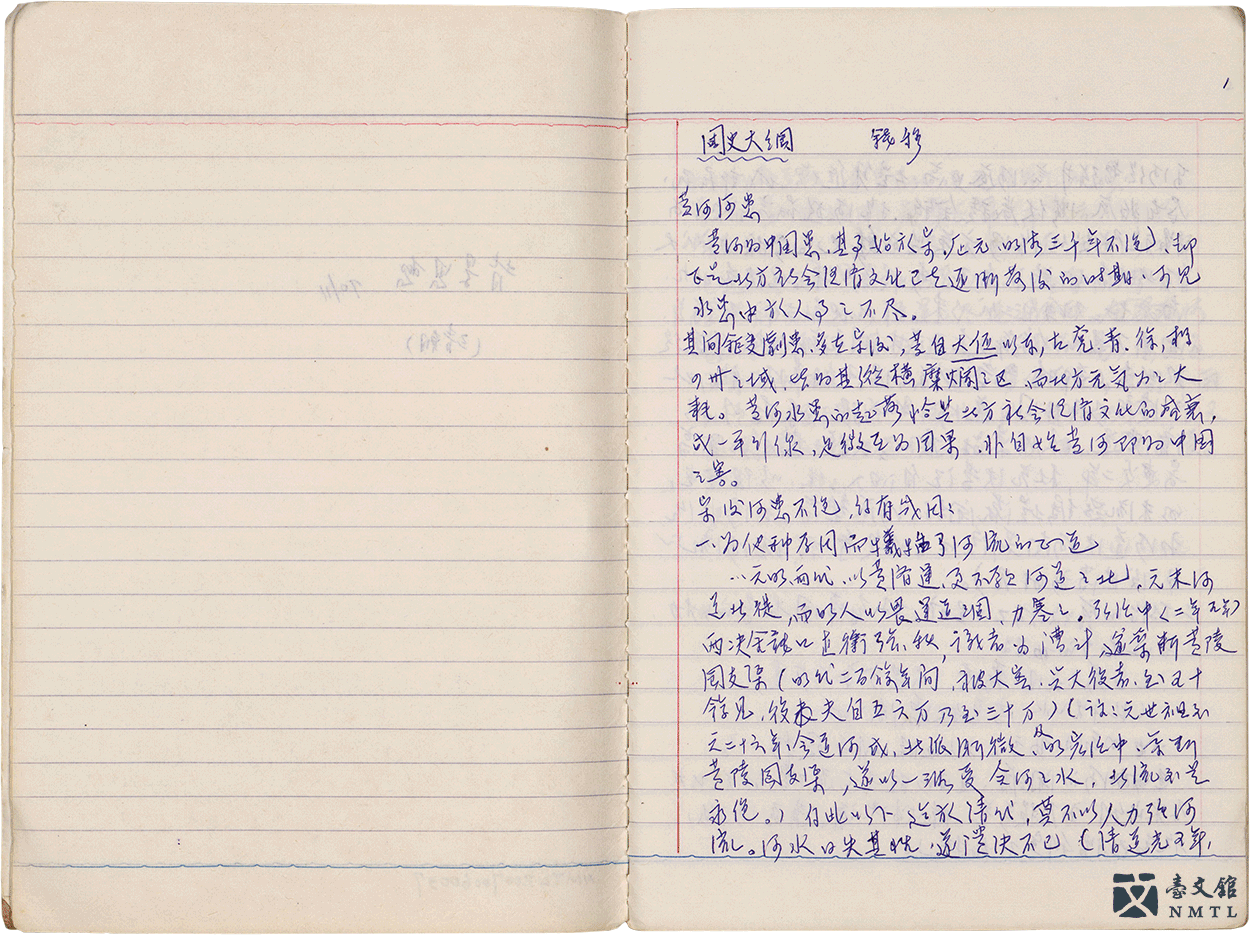
🌊 Yao Chia-wen, Concept Background, manuscript|This is Yao Chia-wen's notes when reading information about the Qing dynasty to make preparations for writing TAIWAN STORY OF SEVEN COLORS. In his notes, he extracted Chien Mu's A GENERAL HISTORY OF CHINA, Deng Tuo's HISTORY OF FAMINE RESCUE IN CHINA and other books related to the Qing dynasty's ideology and development, with red marks underlying important points and remarks on page numbers. (Donated by Yao Chia-wen / From the National Museum of Taiwan Literature permanent collection)
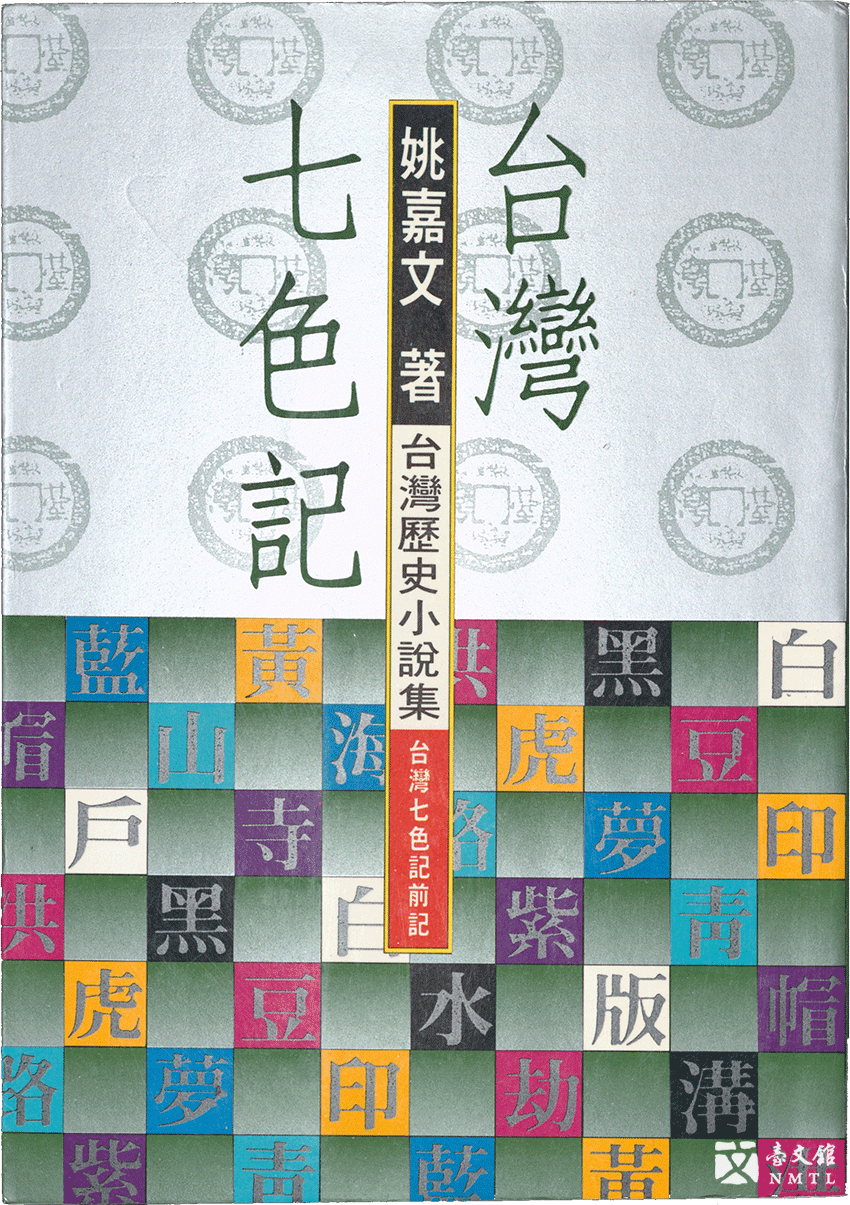
🌊 Yao Chia-wen, Preface to TAIWAN STORY OF SEVEN COLOR|Taipei: Independence Evening Post, 1987. (Donated by Li Kuei-Hsien / From the National Museum of Taiwan Literature permanent collection)
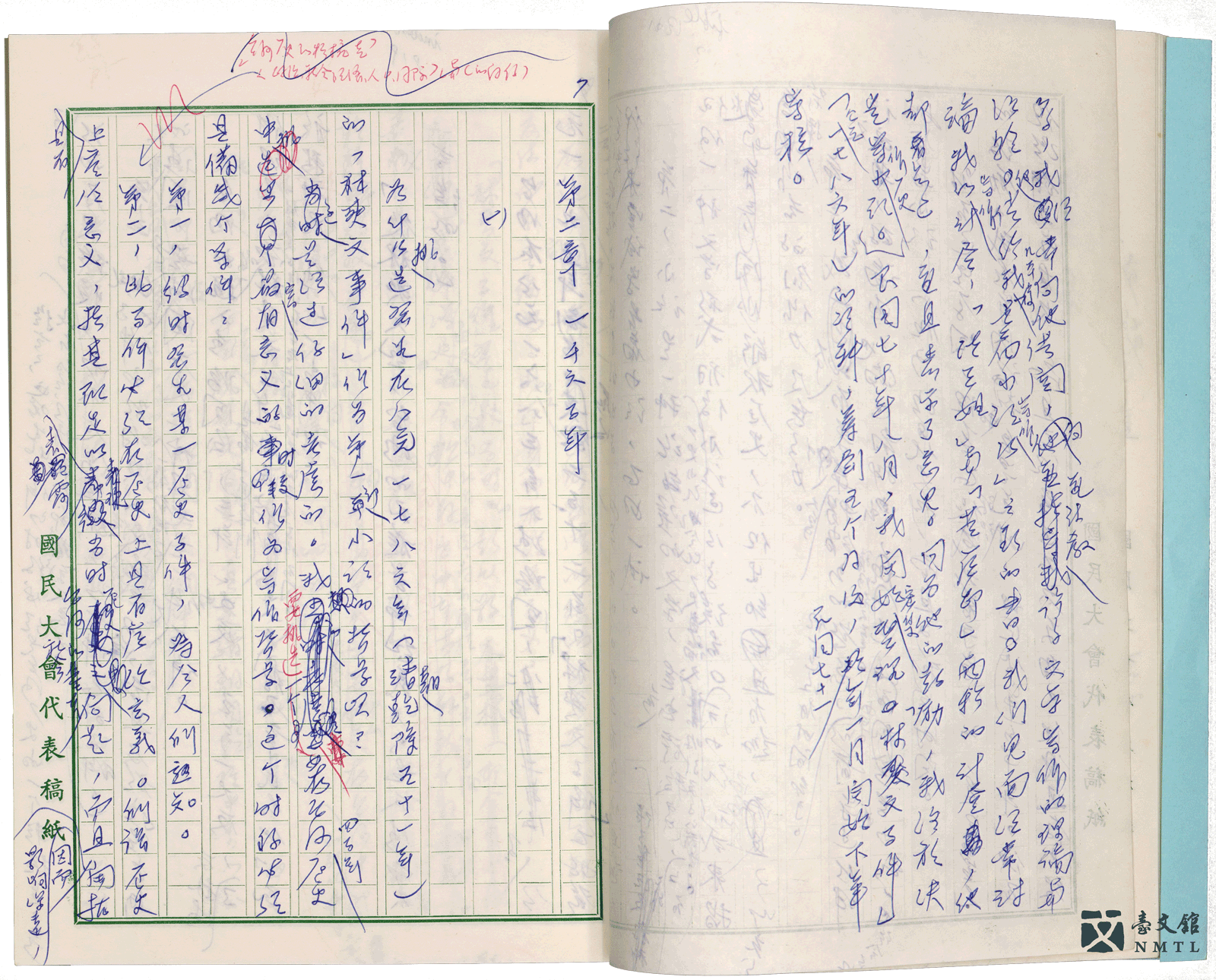
🌊 Yao Chia-wen, first draft of TAIWAN STORY OF SEVEN COLORS, manuscript|This is the first draft of TAIWAN STORY OF SEVEN COLORS, which is divided into 6 chapters. It includes "Reminiscence and Expectations," which covers mainly the trivial memories of the author while he was in jail; "One Thousand and Six Hundred Years" describes how Yao designated the time period for STORY OF SEVEN COLORS; "Color Dyes on Ten Thousand Pieces of Paper" records the method of using ten thousand pieces of manuscript paper to write the story of seven colors; "Running towards the Benchmark" is a description of the mentality and creative process when the author decided a direction for his novel; "History and Historical Novel" is about the author's view on history and historical novels; "Illusion and Reality" is a reflection of the author's sentiments, expressing how he "brought about the colorful stories of his own ancestors and Taiwan people" between the magical illusion of creation and reality. (Donated by Yao Chia-wen / From the National Museum of Taiwan Literature permanent collection)
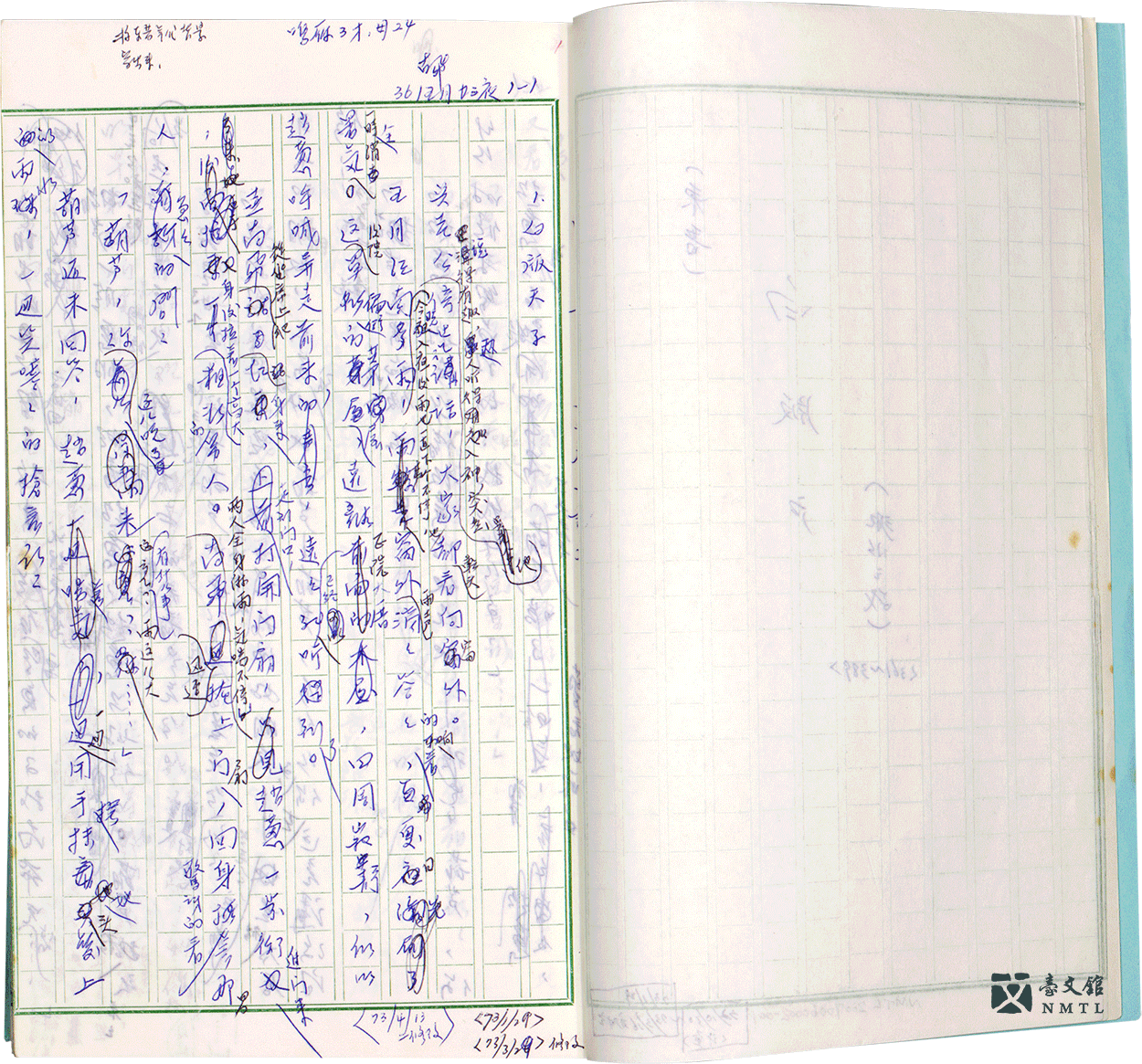
🌊 Yao Chia-wen, first draft, version 1 of PAI PAN HU, manuscript|(Donated by Yao Chia-wen / From the National Museum of Taiwan Literature permanent collection)
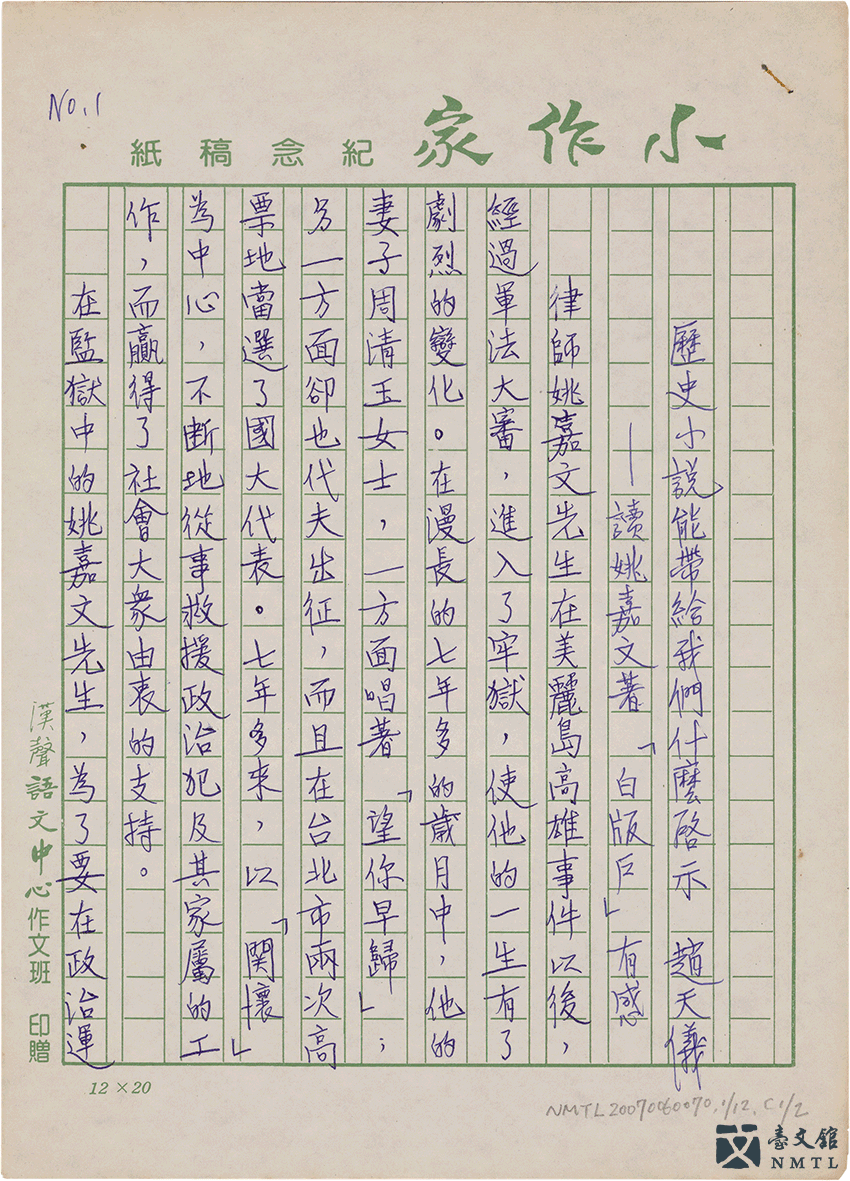
🌊 Chao Tien-Yi, "What Kind of Enlightenment Can Historical Novels Bring Us - impressions after reading Yao Chia-wen's PAI PAN HU," manuscript|This is scholar Chao Tien-Yi's commentary manuscript on PAI PAN HU. Chao thinks Yao has displayed a fastidious approach to the historical research on PAI PAN HU. Upon this base, Yao further made use of Chu Ci, I Ching, arithmetic, Qingtan and other materials to construct historical novels set in the Wei, Jin, and the Northern and Southern Dynasties. However, the extensive reference to historical documents and the traditional narrative style of Chinese classical novels did not stifle PAI PAN HU. Although the characters seemed slightly bland, the author was able to skillfully integrate classical Chinese, colloquial vernaculars, Holo and other languages, creating "a highly readable and contemporary historical novel that arouses affinity." (Donated by Yao Chia-wen / From the National Museum of Taiwan Literature permanent collection)
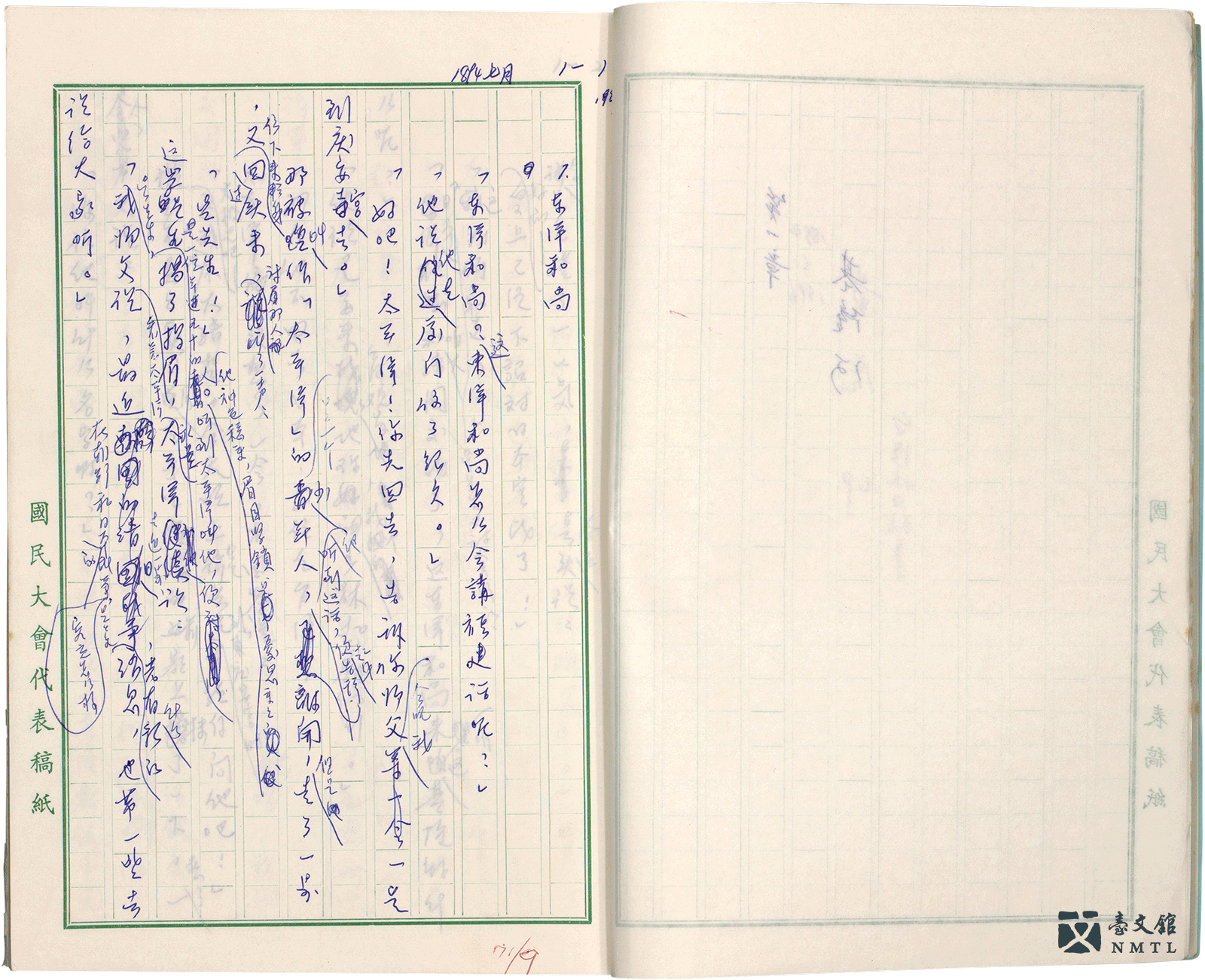
🌊 Yao Chia-wen, HUANG HU YIN first draft, version 1, manuscript|(Donated by Yao Chia-wen / From the National Museum of Taiwan Literature permanent collection)
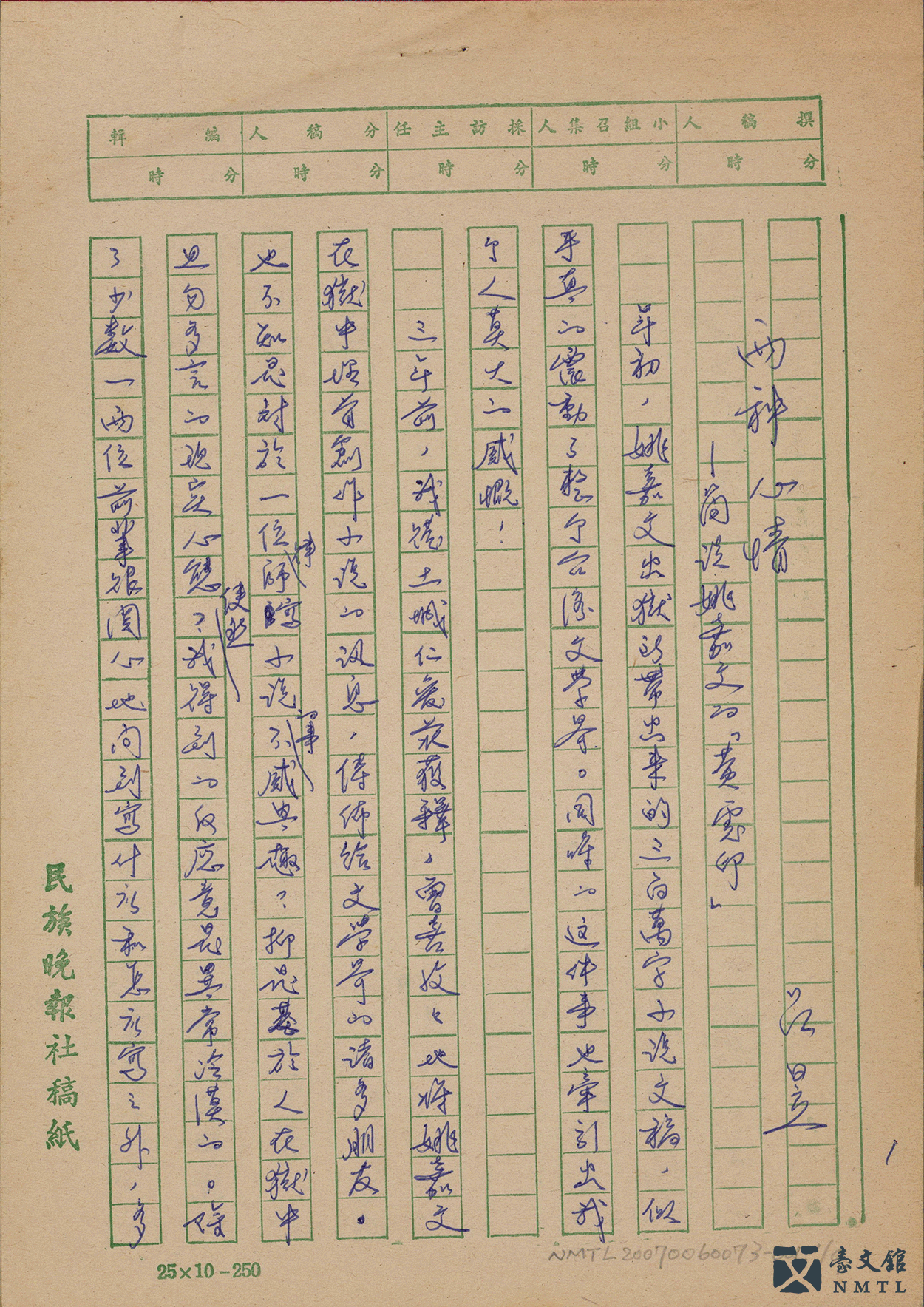
🌊 Lu yu, "The Two Kinds of Feelings – a brief review about Yao Chia-wen's HUANG HU YIN," manuscript|This is Lu Yu's commentary manuscript on HUANG HU YIN. Lu first talks about his friendship with Yao Chia-wen while in prison, and how they cooperated in sending out the manuscript of HONG TOU CHIEH; the latter part is an analysis of the strengths and weaknesses of HUANG HU YIN, commenting on the inadequate substance of the characters, but concluding that the novel has sufficient symbolic language and rich historical information to illustrate the long historical development of Taiwan, which is groundbreaking for a historical novel. (Donated by Yao Chia-wen / From the National Museum of Taiwan Literature permanent collection)
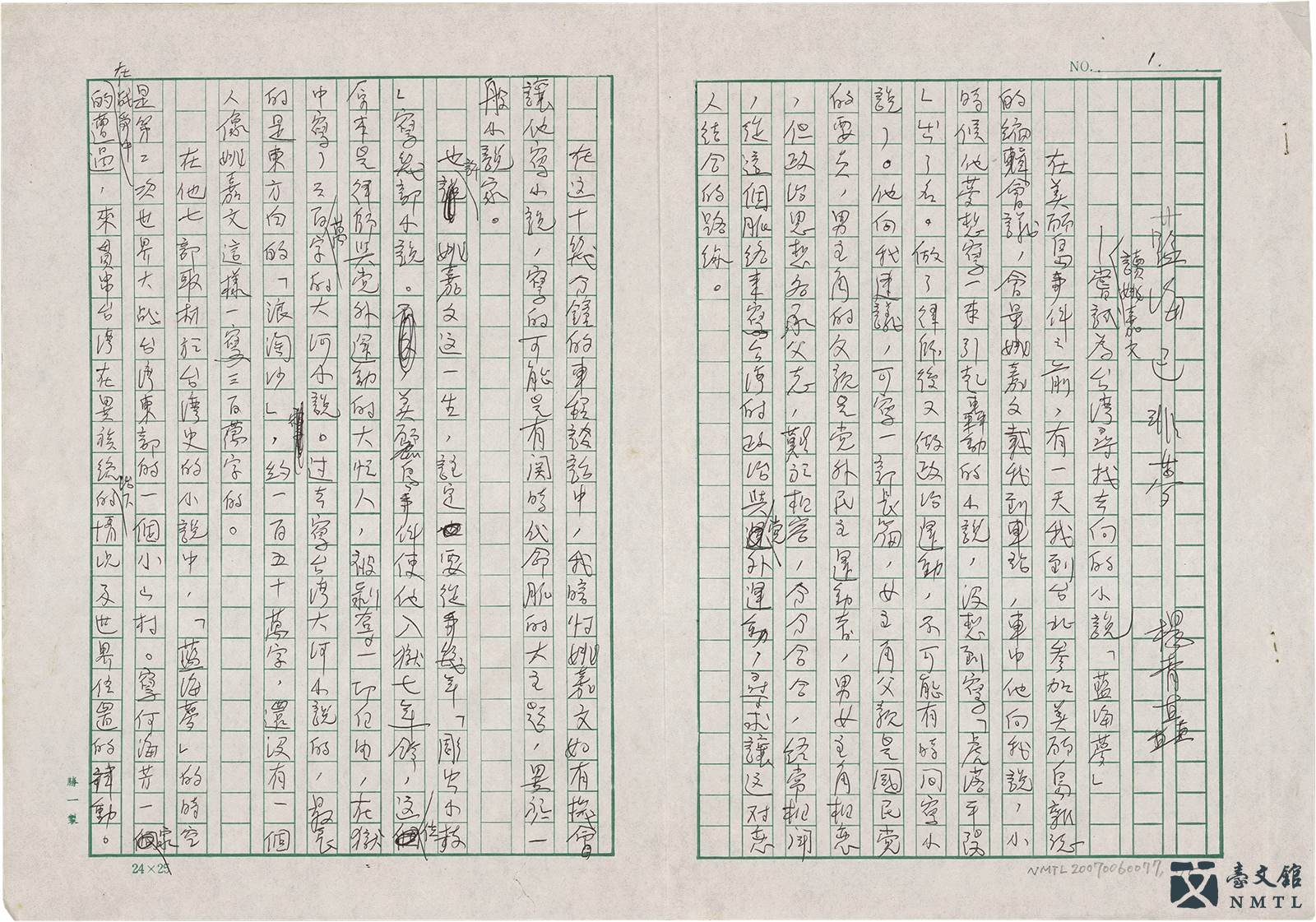
🌊 Yang Ching-Chu, "The Blue Ocean is no Longer a Dream – reading Yao Chia-wen's LAN HAI MENG in an attempt to find a direction for Taiwan," manuscript|This is Yang Ching-Chu's commentary manuscript on LAN HAI MENG. Yang first describes a previous discussion he had with Yao, where Yao mentioned a conflicting love relationship between children of Kuomintang member and Tangwai (non-party) personalities, which became a starting point for their discussion about LAN HAI MENG. Yang continues by discussing Yao's vivid imagery in his novel, which differs from others who are often vague and weak in this aspect. Yang considers Yao's use of directions to name the chapters suggestive of Taiwan's future direction, and referential for the people of Taiwan. (Donated by Yao Chia-wen / From the National Museum of Taiwan Literature permanent collection)
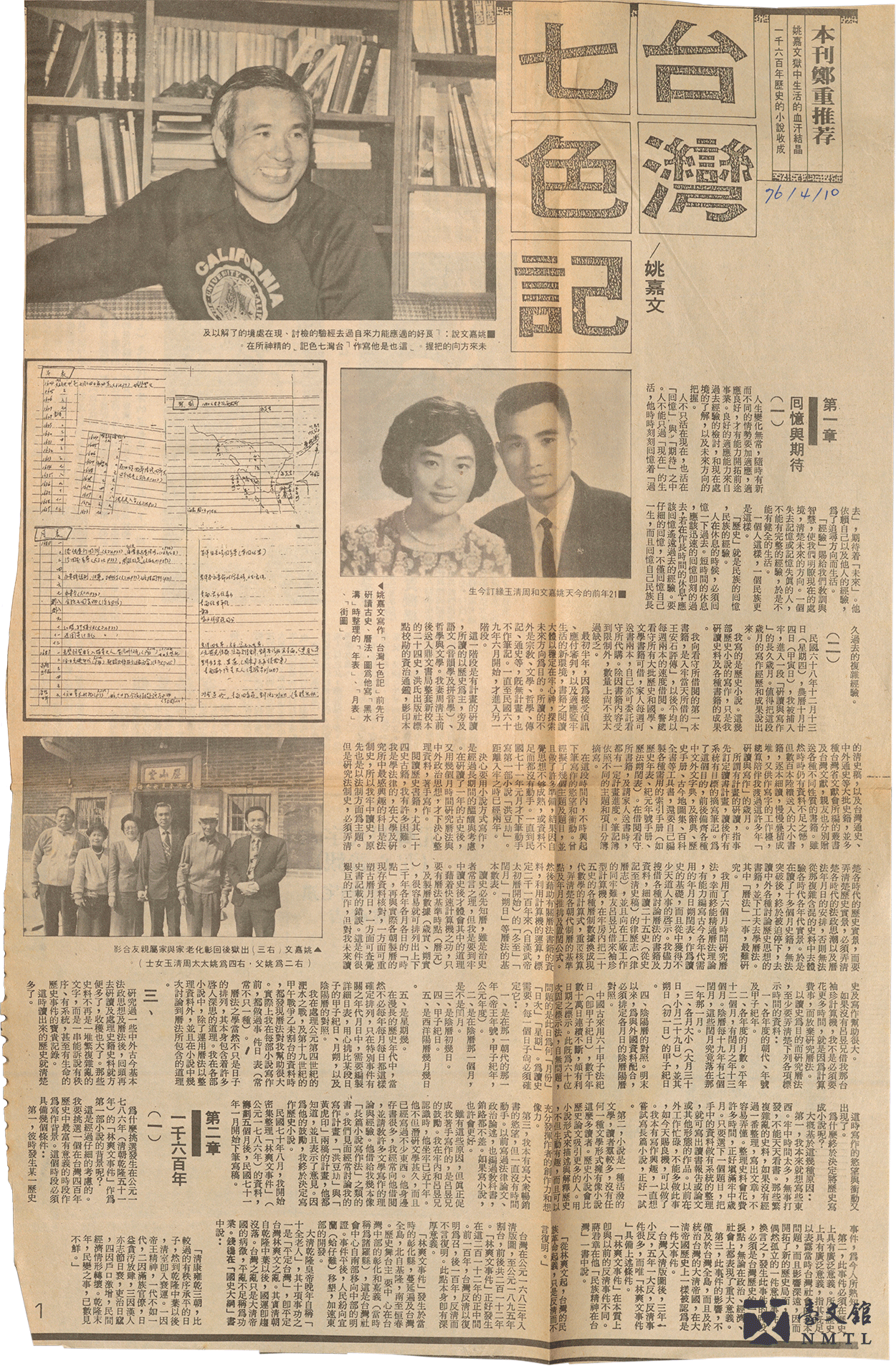
🌊 "Taiwan Story of Seven Colors" published in instalments in a newspaper|(Donated by Yao Chia-wen / From the National Museum of Taiwan Literature permanent collection)
Chen Yeh (1959-2012)

Born Chen Chun-hsiu, in a distinguished family in Tainan. While she was teaching in Jianguo High School, she was dubbed the "Spicy Teacher" with her unique teaching style. Chen once described her literary writing as "faithfully recording how the people strive for living on this land." Her creative talent is derived from her extraordinary family background and personal circumstances. Her own inner struggles, the intricacies of clans, and the history of Taiwan form the very basis of her literary writings. She is also well-versed in writing about gender awareness and sexual liberation. Her style, considered bold yet lavishly elegant, adequately demonstrates the self-liberation process of creative women, and proves a legacy for Taiwan's historical perspective from the female-oriented narrative.
📚 MUD RIVER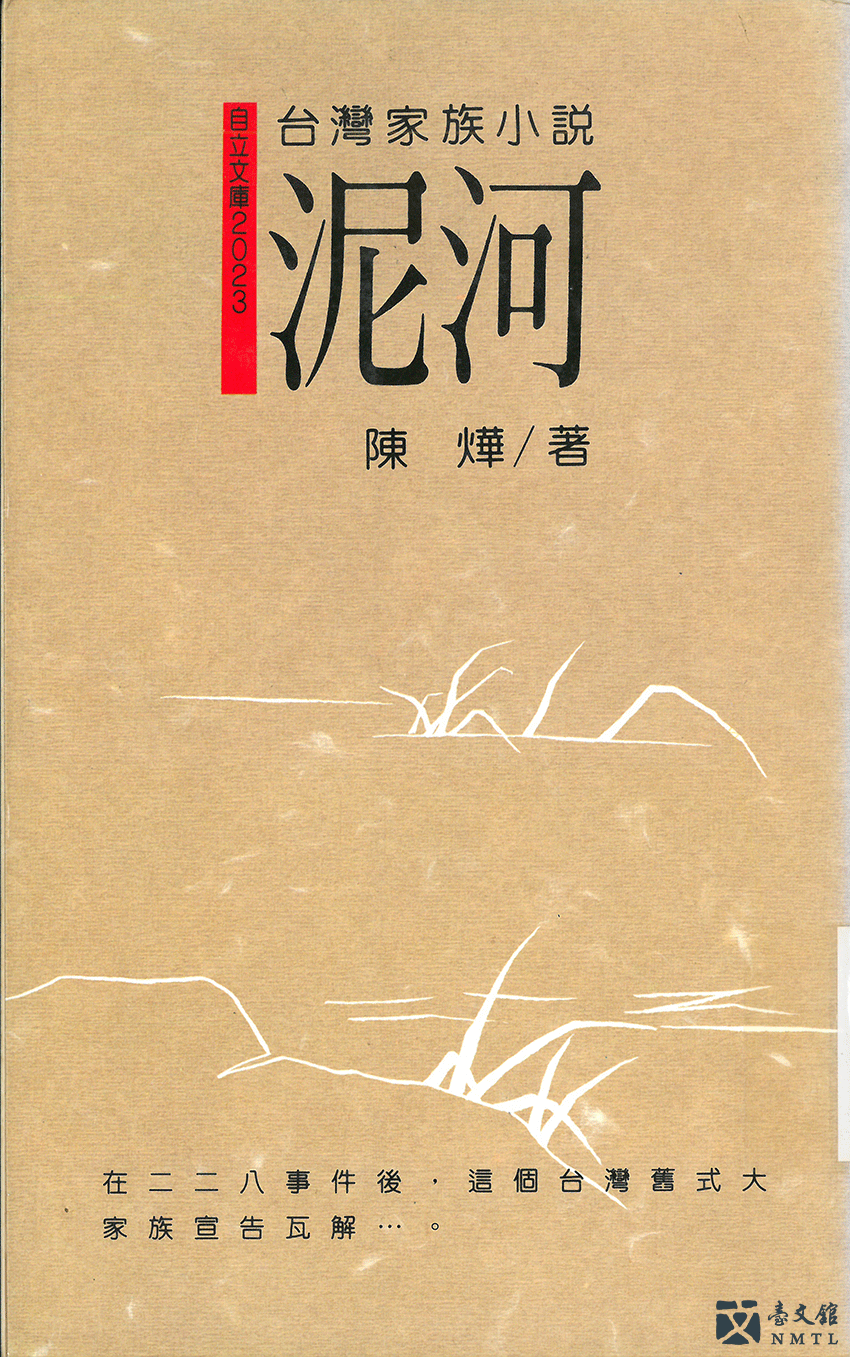
Chen Yeh wrote MUD RIVER in 1984, which was published as a series in the local supplement of the INDEPENDENCE EVENING POST in 1988. A separate edition was published in 1989, and in 2002, a rewrite of the story titled LIEH AI CHEN HUA was issued. The story consists of 3 parts: MISTY RIVER BANK, MUD RIVER and ON THE OTHER SIDE OF THE RIVER, TOMORROW. The story is about the downfall of a big family clan in Tainan just after the 228 Incident, with the "canal", the City's landmark, in the background. The 3 protagonists of the story: Cheng Chen-hua, Lin Cheng-sen and Lin Bing-cheng were entangled in a tumult between conflict and love, suffering and redemption. Historical notions, identification of the land and passionate love were incorporated into the storyline, revealing a political concern and ideological criticism that is rarely seen in female-oriented narratives.
The white peonies are blooming one after another on both sides; the fragrance was so strong it made her tipsy; she staggered along the bank of the river, where the anchored boat nestled quietly by the canal.
──Chen Yeh, MUD RIVER
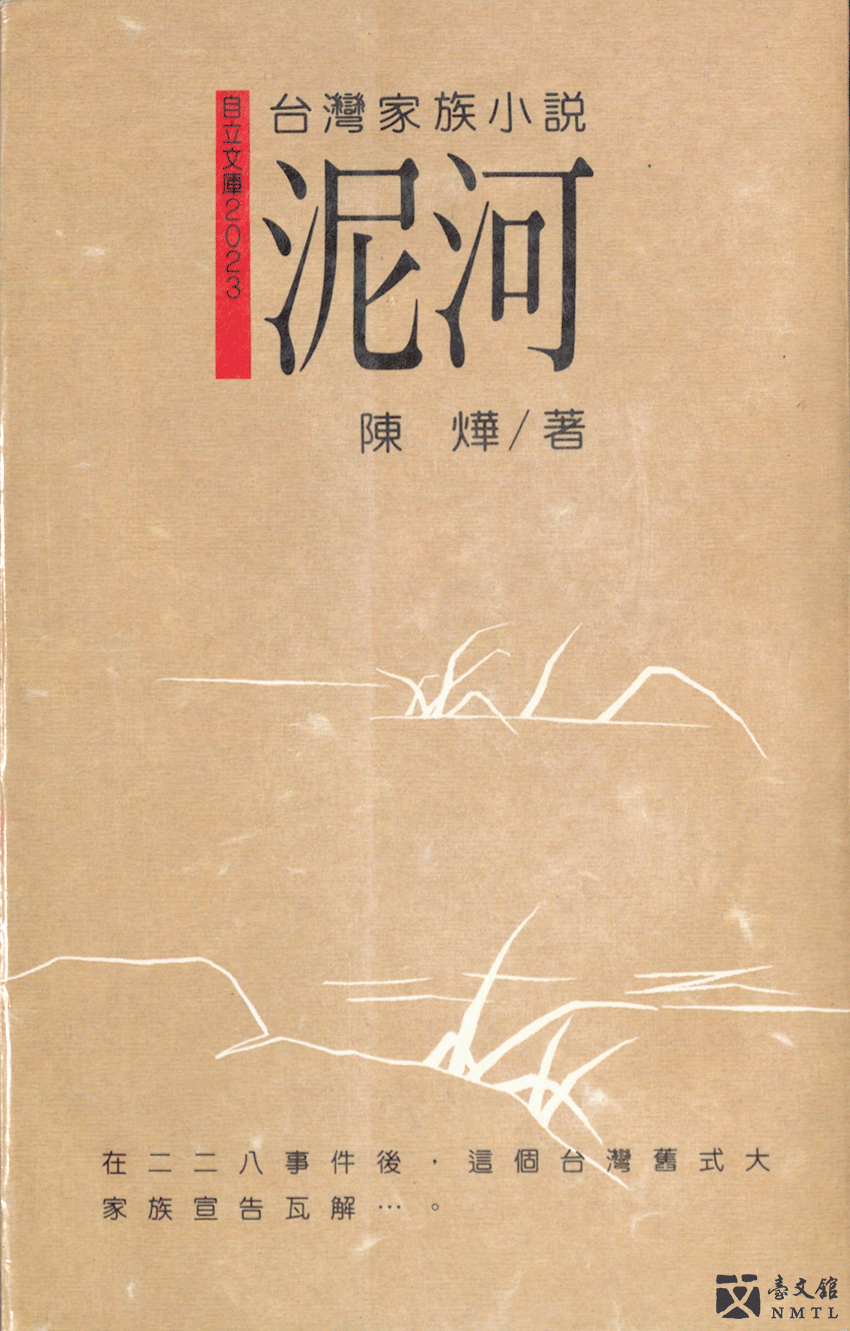
🌊 Chen Yeh, MUD RIVER|Taipei: Independence Evening Post Publishing House, 1989.
This book not only incorporates the author's personal family story, but also integrates the history of Tainan and the collective memories of an era, with an adequate rendition of the emotional complexities of the family clans. In addition, this is the first novel exploring the 228 Incident and the trauma of the White Terror from the female perspective. The author observed from her vulnerable position as a woman, and brought forth the chaotic and turbulent times in the modern history of Taiwan. This is therefore an important literary work revealing the 228 Incident upon the lifting of the martial law. (Donated by Chen Yeh / From the National Museum of Taiwan Literature permanent collection)
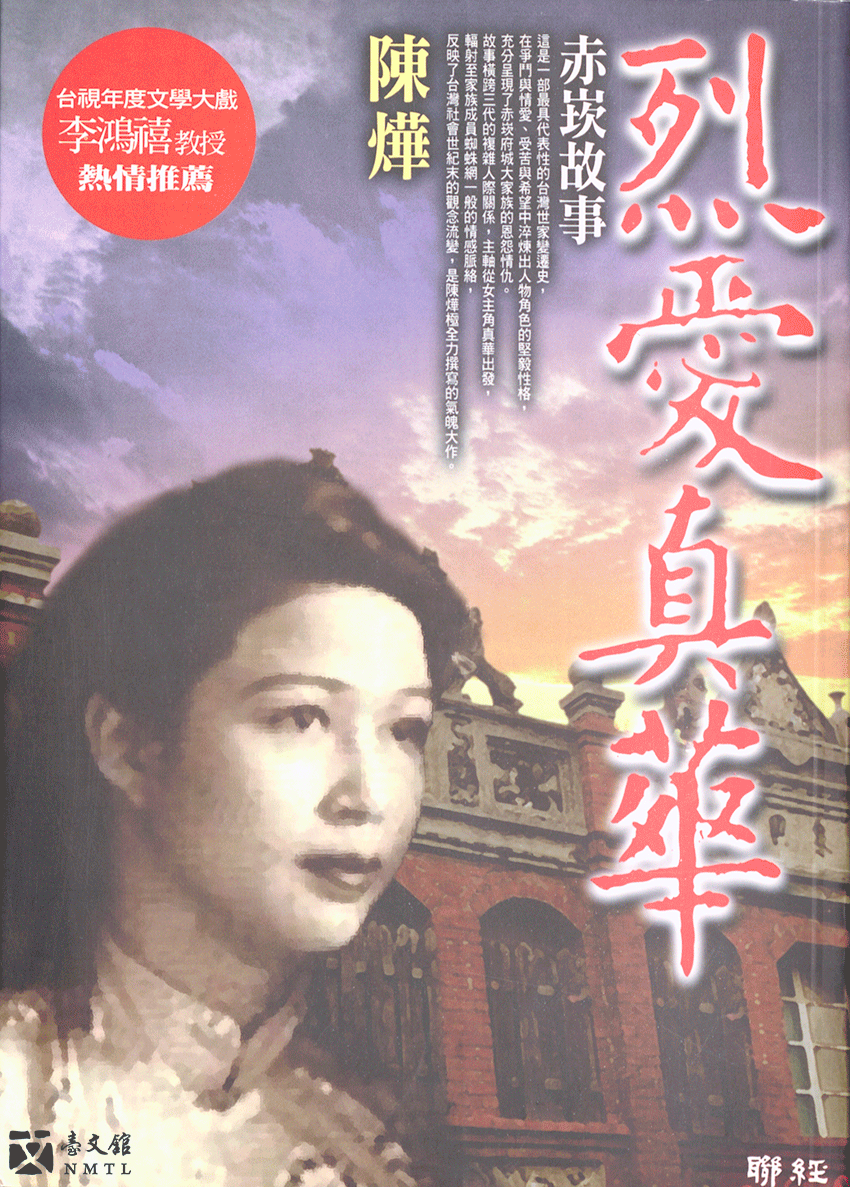
🌊 Chen Yeh, LIEH AI CHEN HUA|Taipei: Linking Publishing, 2002.
This is an adaptation of the story MUD RIVER, wherein the story revolves around the complex cobweb of struggle, love, suffering and hope in a big family in thecastle town in Tainan. About the adaptation, Chen Yeh stated that, "Adapting from MUD RIVER serves two purposes: one is to make the story more attractive, while the other is my way to reconcile with my father through creative writing." (Donated by Chen Yeh / From the National Museum of Taiwan Literature permanent collection)
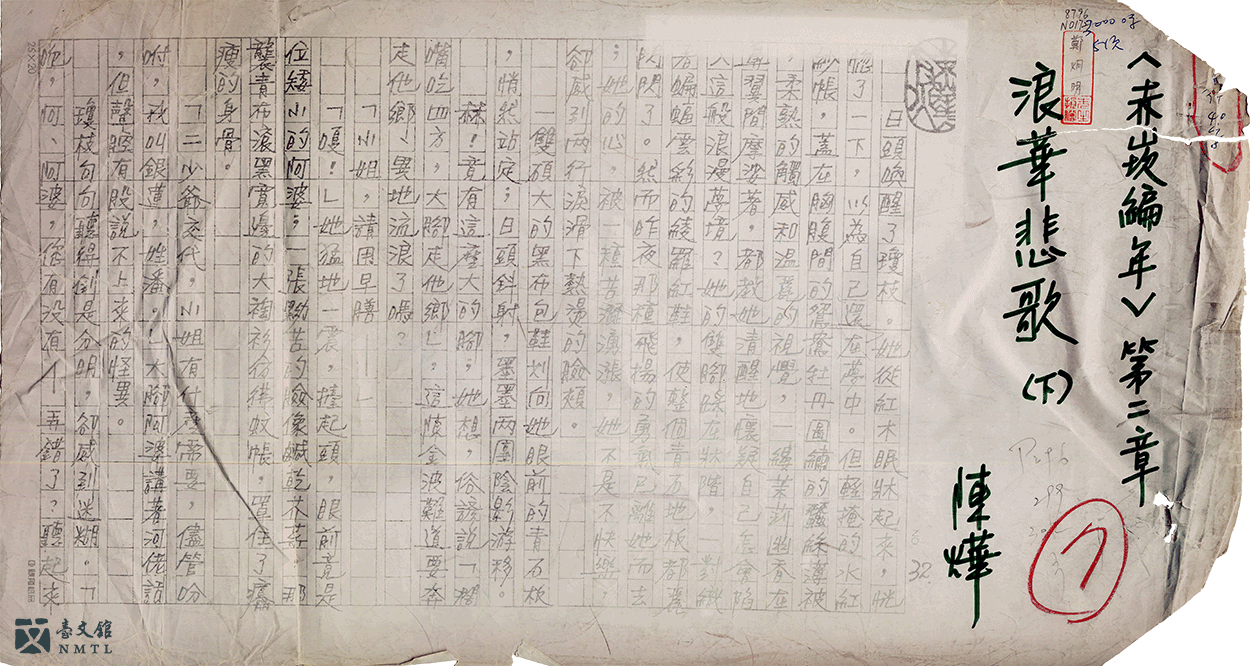
🌊 Chen Yeh, THE CHRONOCLES OF CHIHKAN, Chapter 2, The Tragedy of Langhua, manuscript, photocopy|In 1992, Chen Yeh began to write the long family novel series "The Chihkan Tales." It was her attempt at writing Roman-Fleuves from an angle different from those of male authors. This work is one of the chapters, which describes the love story and marriage of an adopted daughter in Tainan during the Japanese occupation. This work had been published in LITERARY TAIWAN (Issues 10 &11). (Donated by Literary Taiwan Magazine / From the National Museum of Taiwan Literature permanent collection)
Q&A
Q:Which Roman-Fleuve has the greatest number of words?
A:TAIWAN STORY OF SEVEN COLORS, by Yao Chia-wen.
Yao Chia-wen 's TAIWAN STORY OF SEVEN COLORS has 7 tales in 14 volumes, and a separate volume for "PREFACE." It is the largest-scale Romans-Fleuve in Taiwan, consisting of more than 3 million words in total. The book was published in 1987 and composed of 7 long series of stories, each marked with a different color in accordance with the sequence of the times, forming an almost complete history of Taiwan.
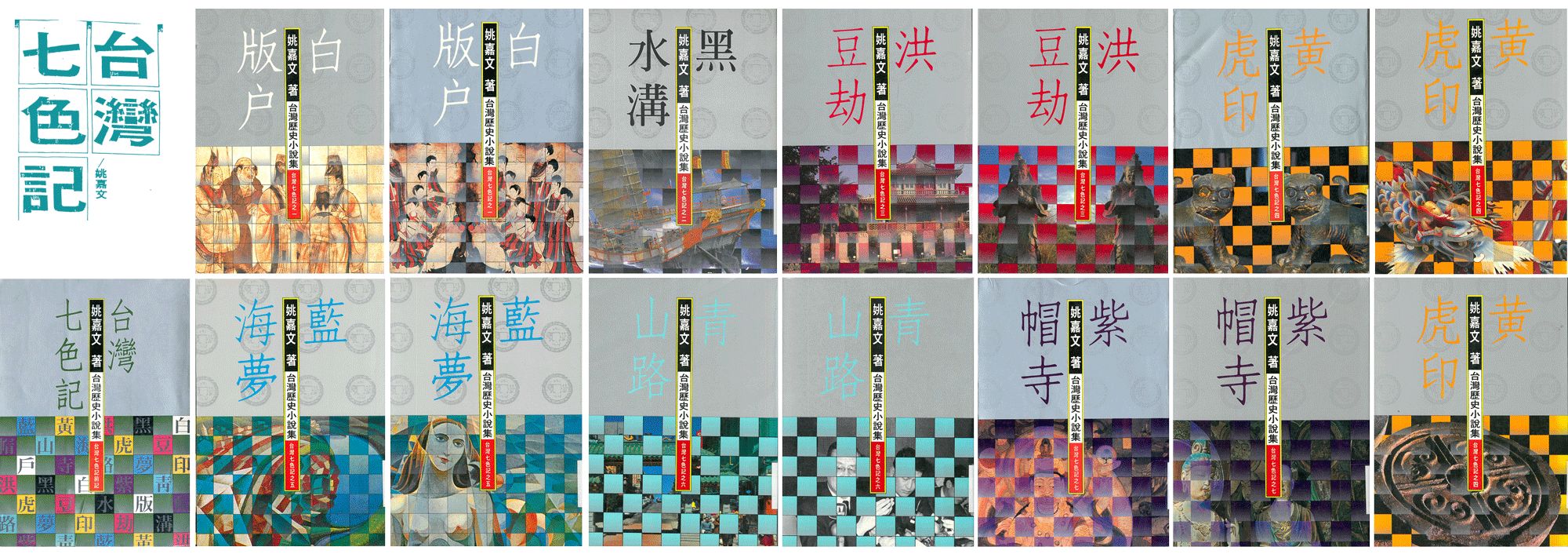
Q:Which important landmark in Tainan was Chen Yeh's MUD RIVER set against?
A:The Tainan Canal.
Although the book MUD RIVER had not been published in the form of a connected series, it used the famous "Canal" in Tainan as the story background throughout. After the 228 Incident, the doom of the family clan seemed to mimic the history of Taiwan. The author brought attention to female writing through this work.
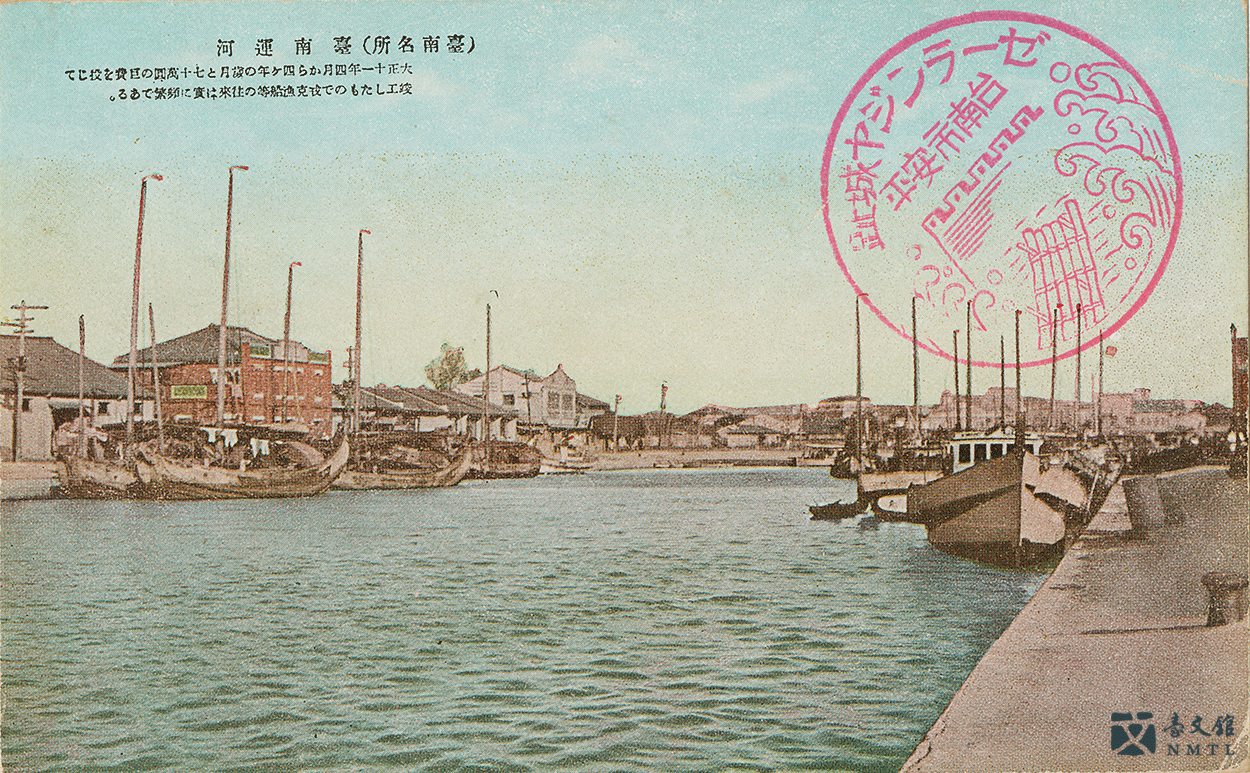
🌊 The Tainan Canal|(Provided by the National Museum of Taiwan History)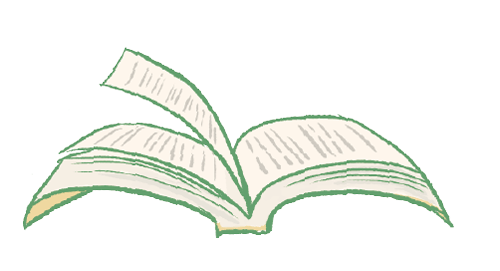
Lin Bing-cheng walked along the bank of the canal on Anping Road, all alone. Under the night sky, as the heavy rain had just stopped, a few scattered stars, and the haunted land soaked in moisture, eerily followed closely behind him.
──Chen Yeh, MUD RIVER



